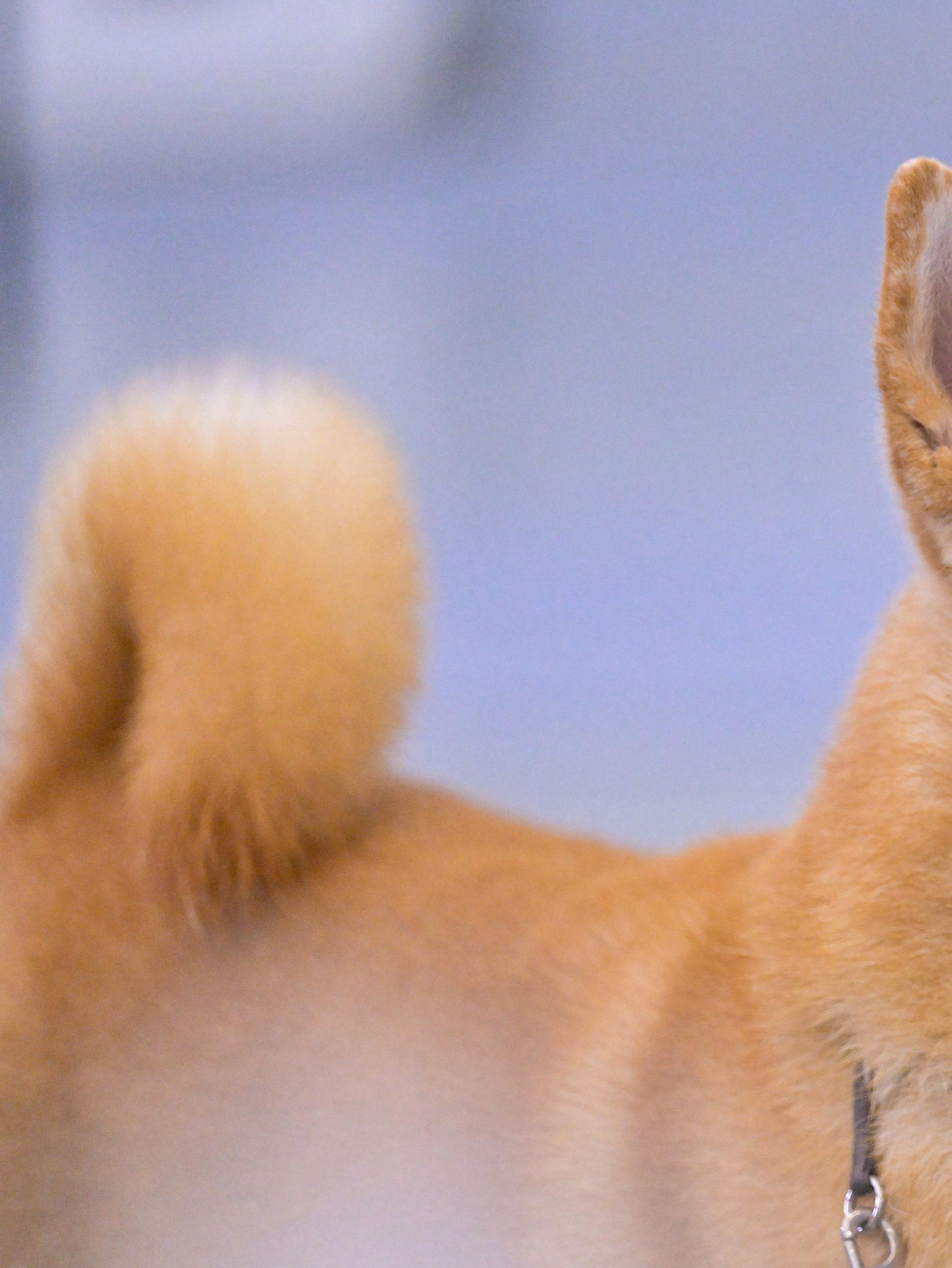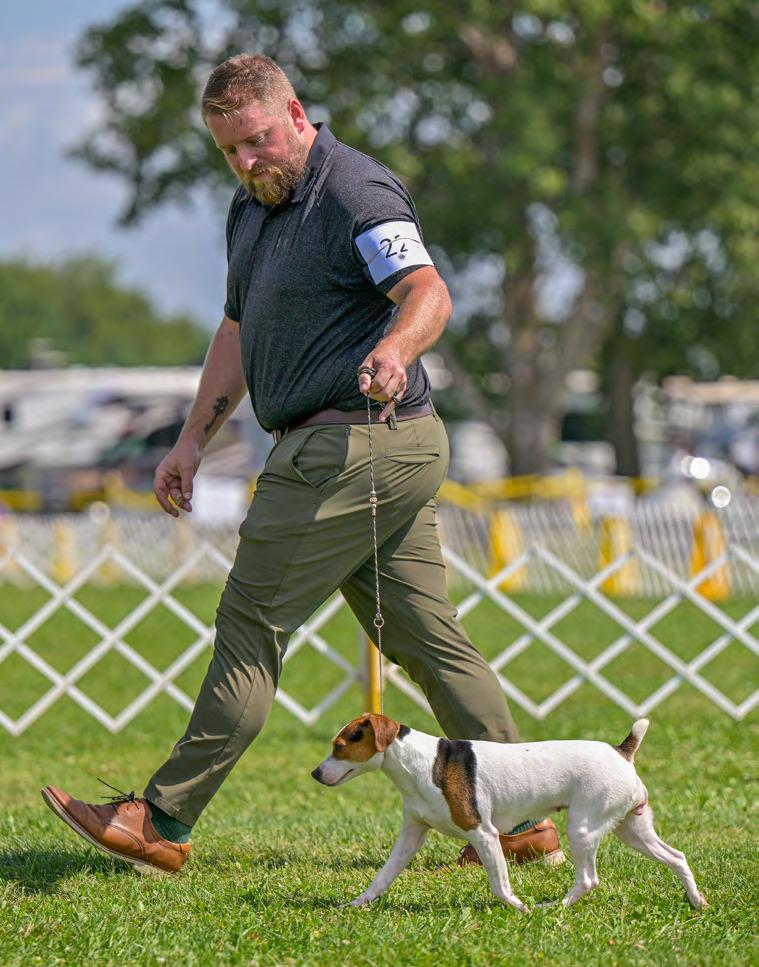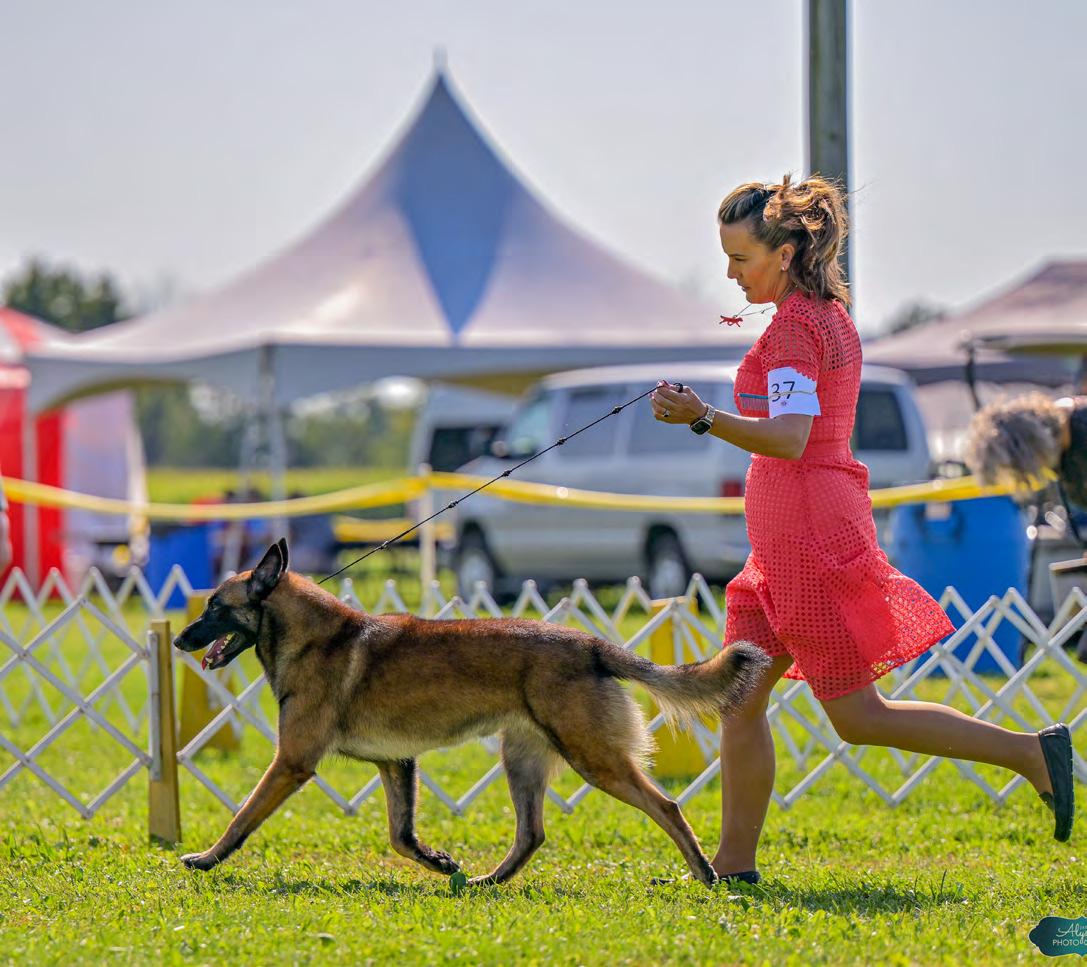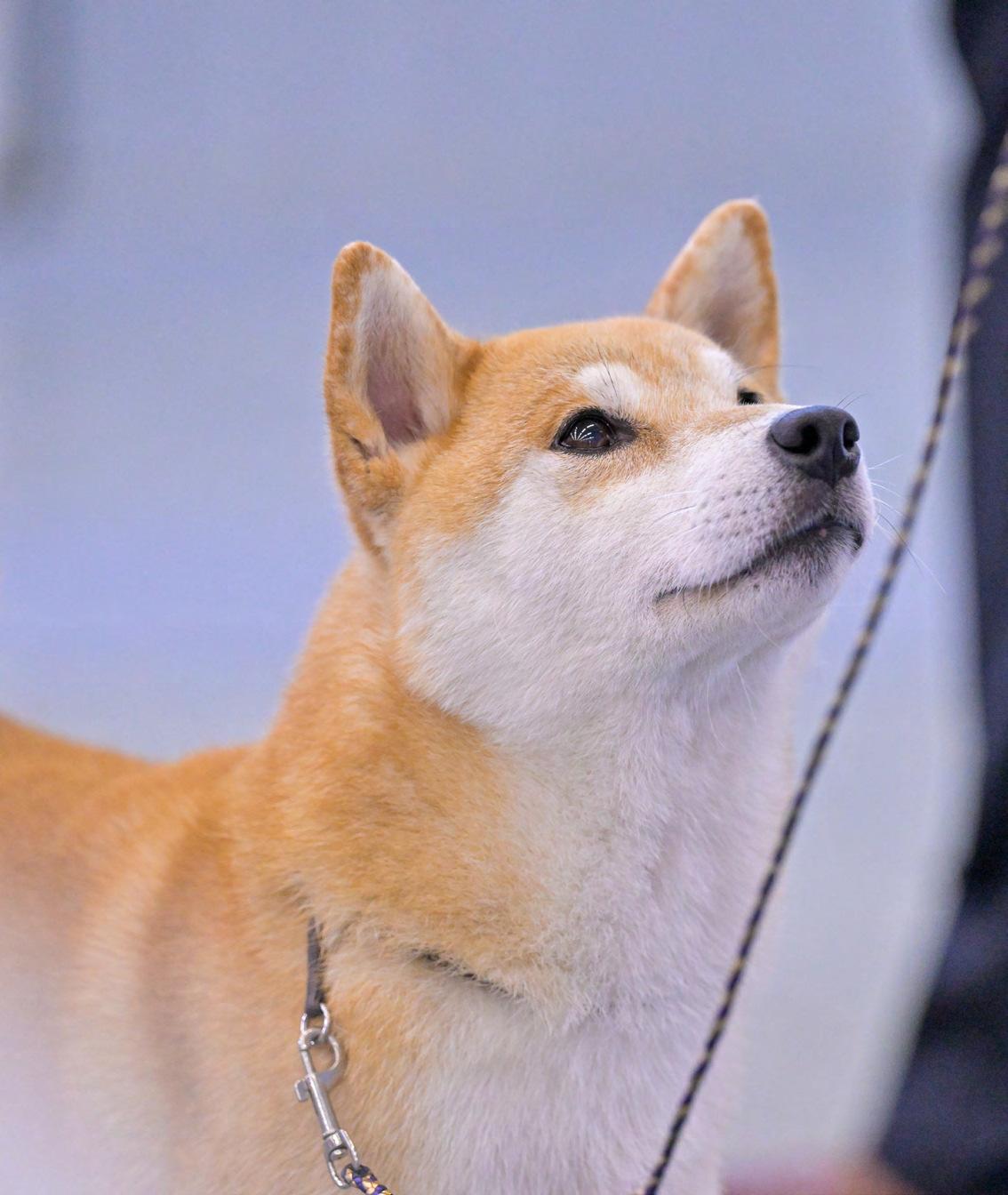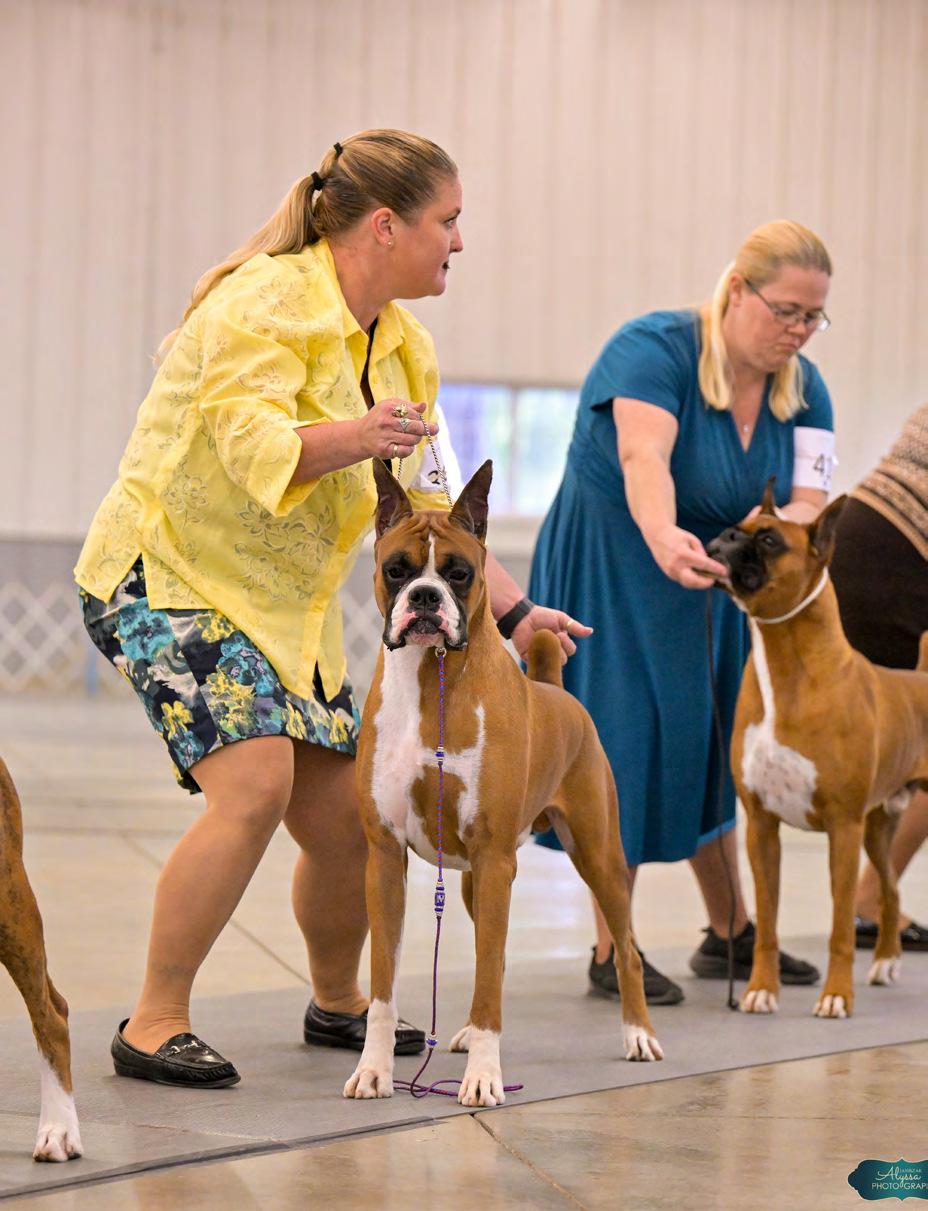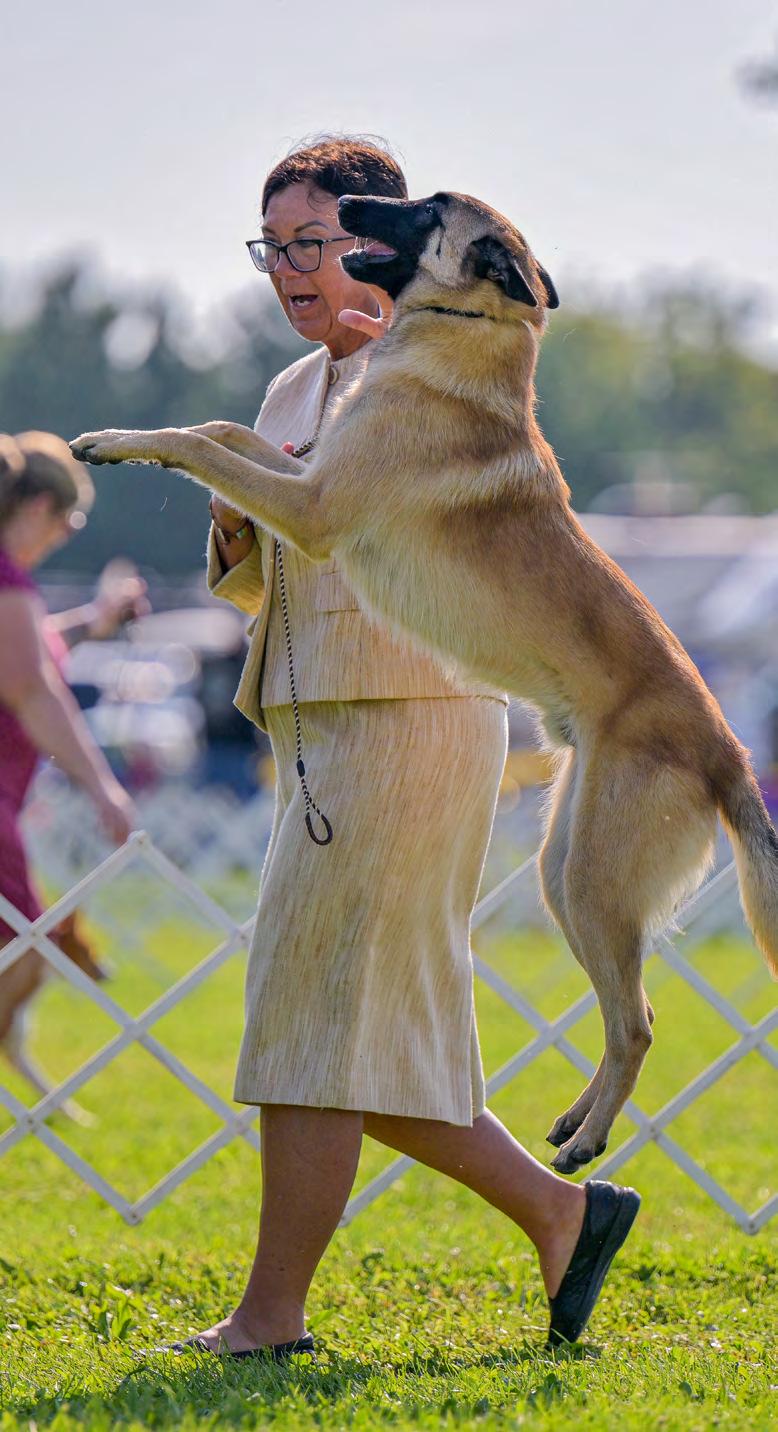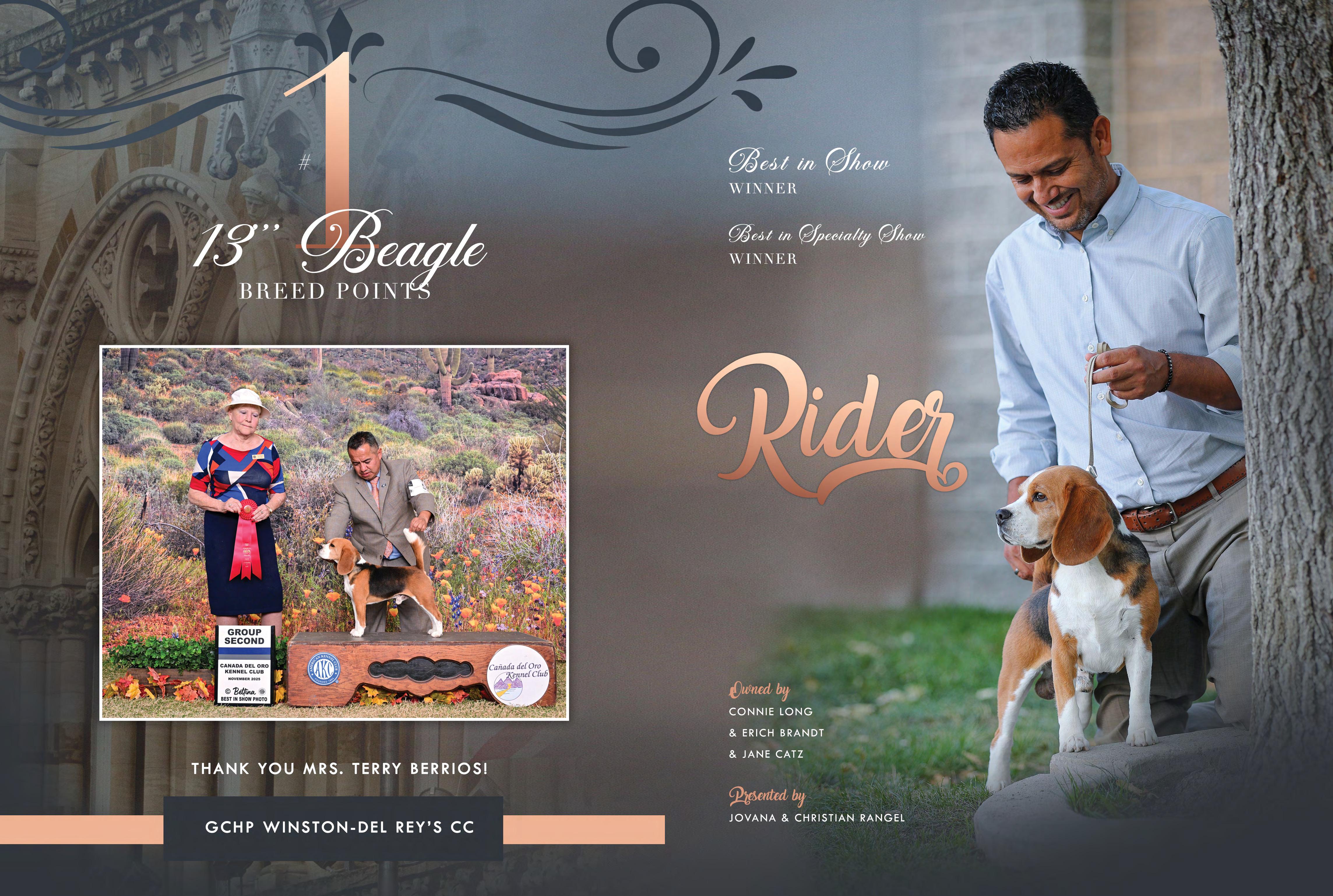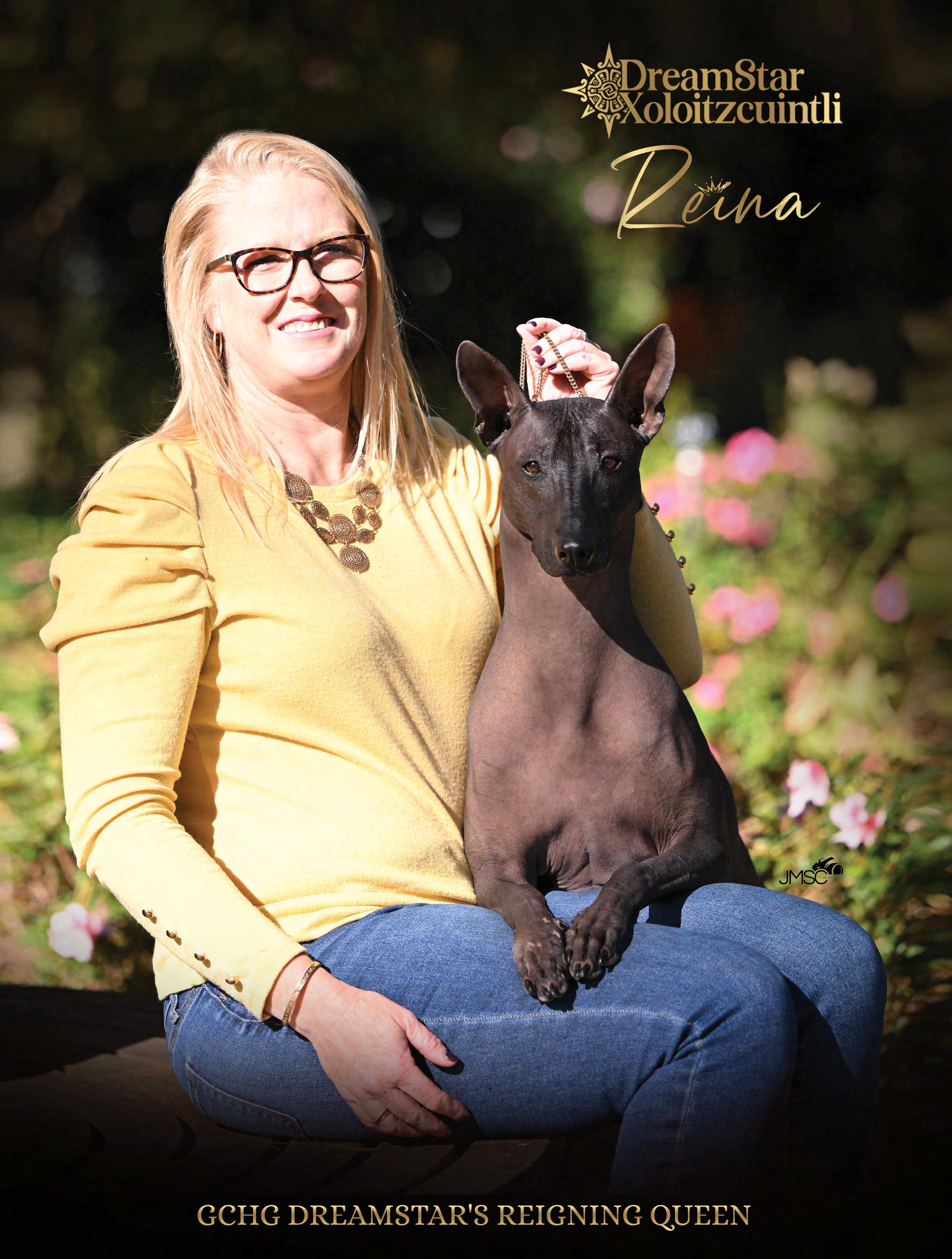








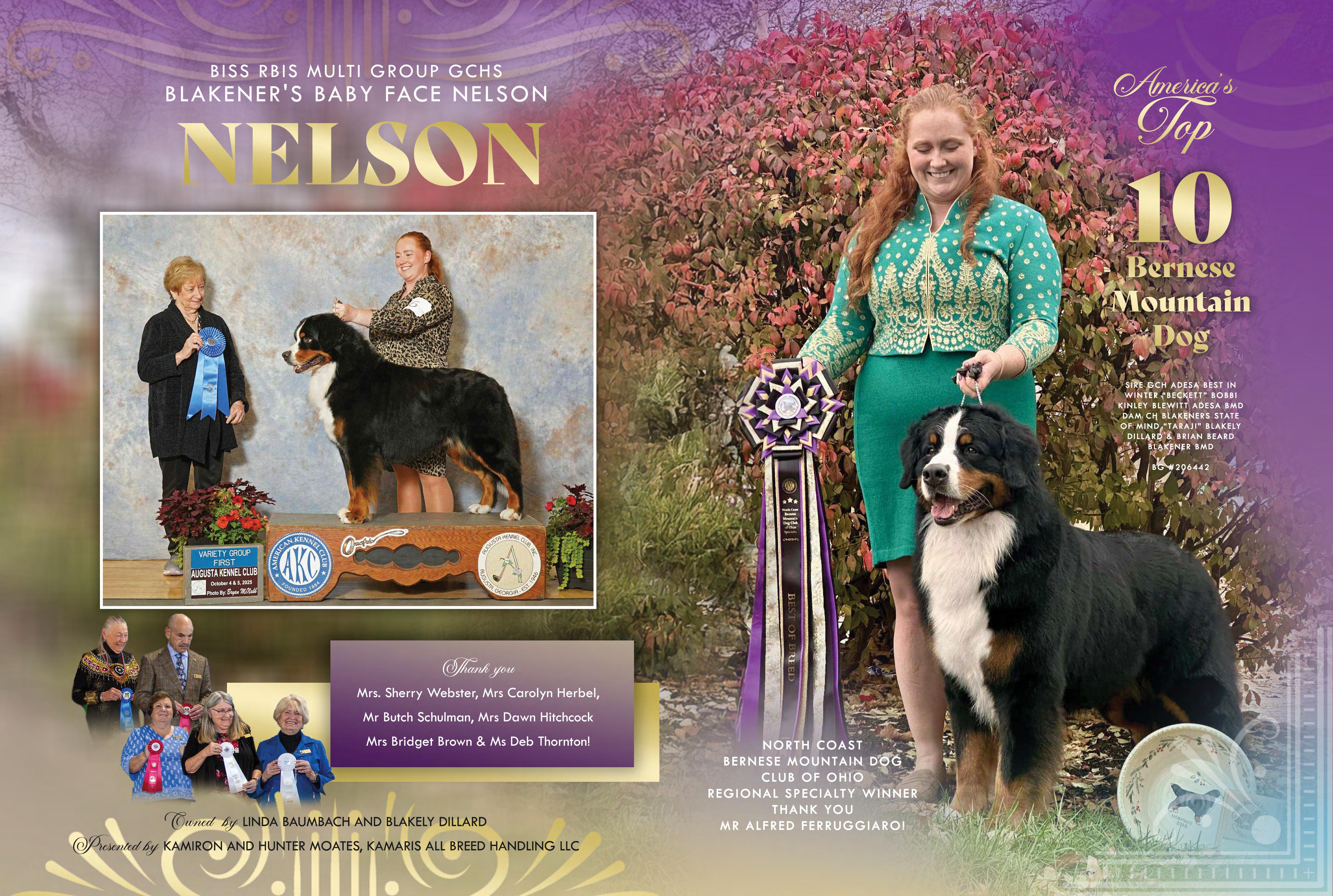

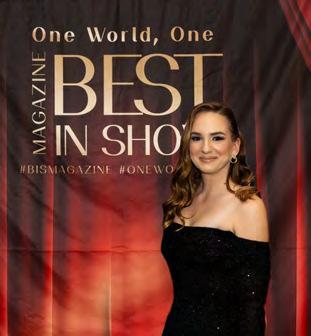













As we close out the year, I’m proud to present our final issue of the season. What a journey it has been—shows, stories, unforgettable wins, and the incredible community that continues to inspire everything we do. Thank you to all our readers, contributors, advertisers, handlers, breeders, and friends who have supported this magazine throughout the year. Your passion and dedication are the heart of every issue.
This month, we’re introducing an exciting new column highlighting the experiences of international exhibitors and handlers traveling to the United States. Their stories add a fresh perspective to the American dog-show scene, and we’re thrilled to bring their voices to our pages.
And we’re not stopping there. Behind the scenes, we’re already preparing another brand-new column debuting in our 2026 issues—something we believe will bring even more depth, insight, and inspiration to the dog-show community.
Thank you for being part of our magazine family. Here’s to an amazing year behind us and an even more exciting one ahead.


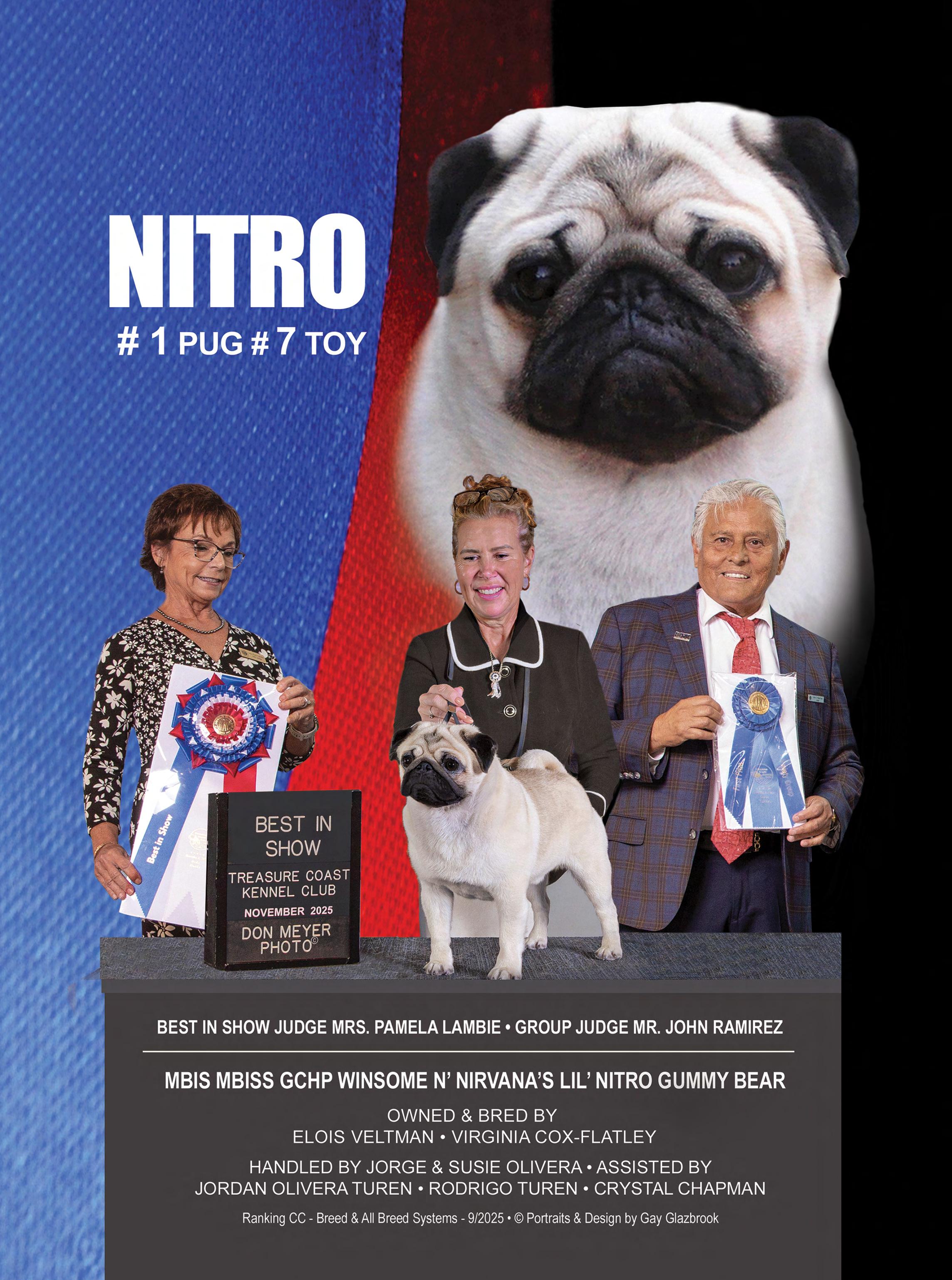






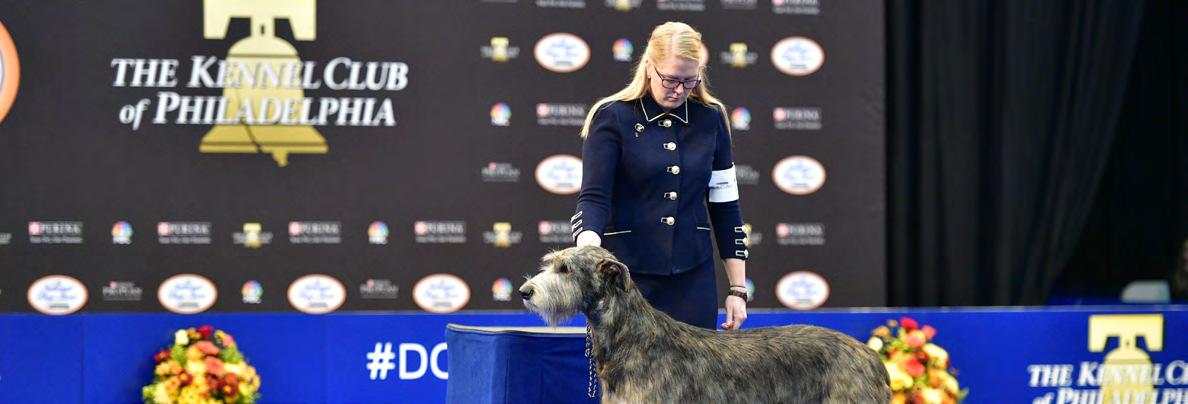




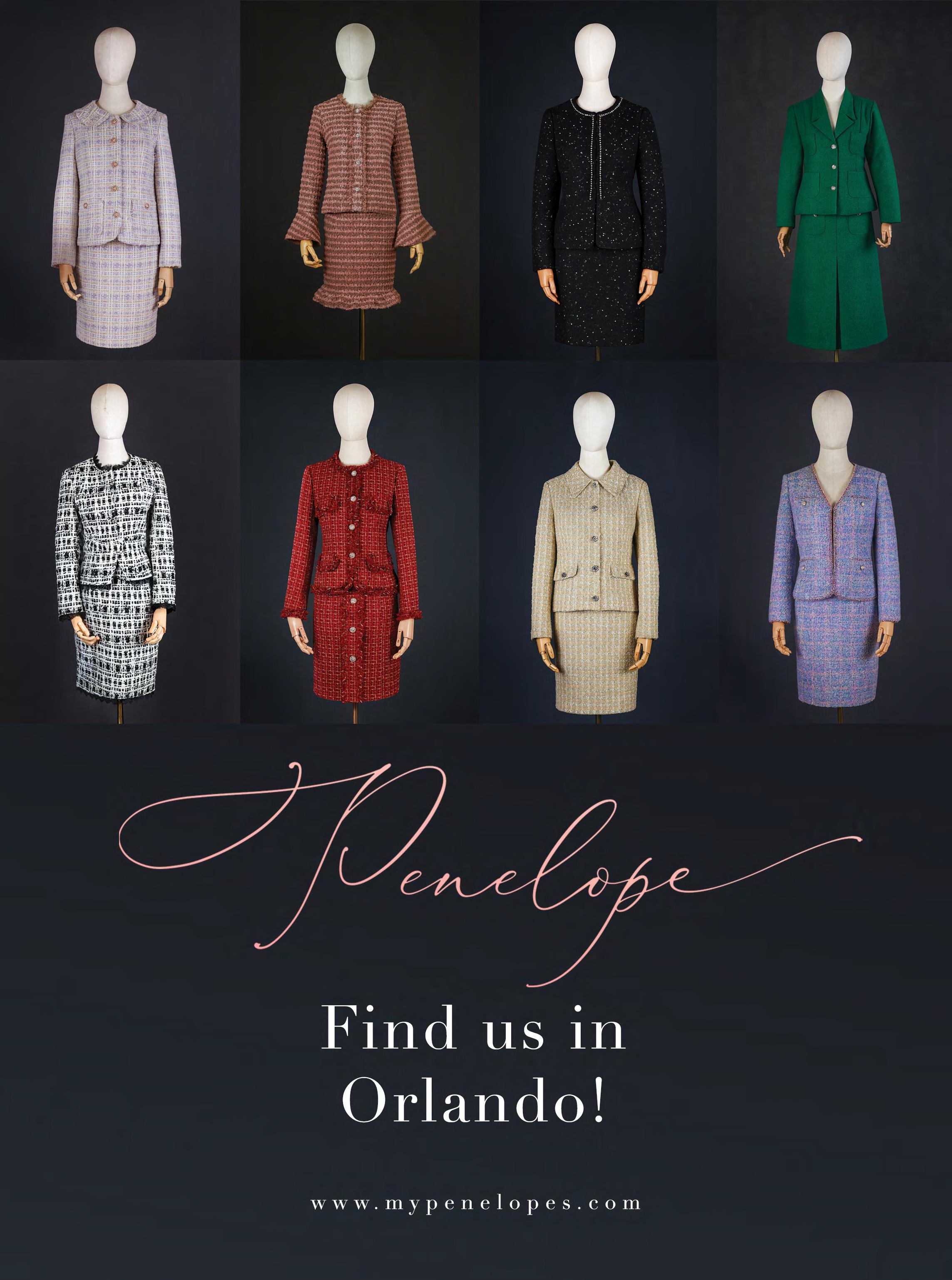






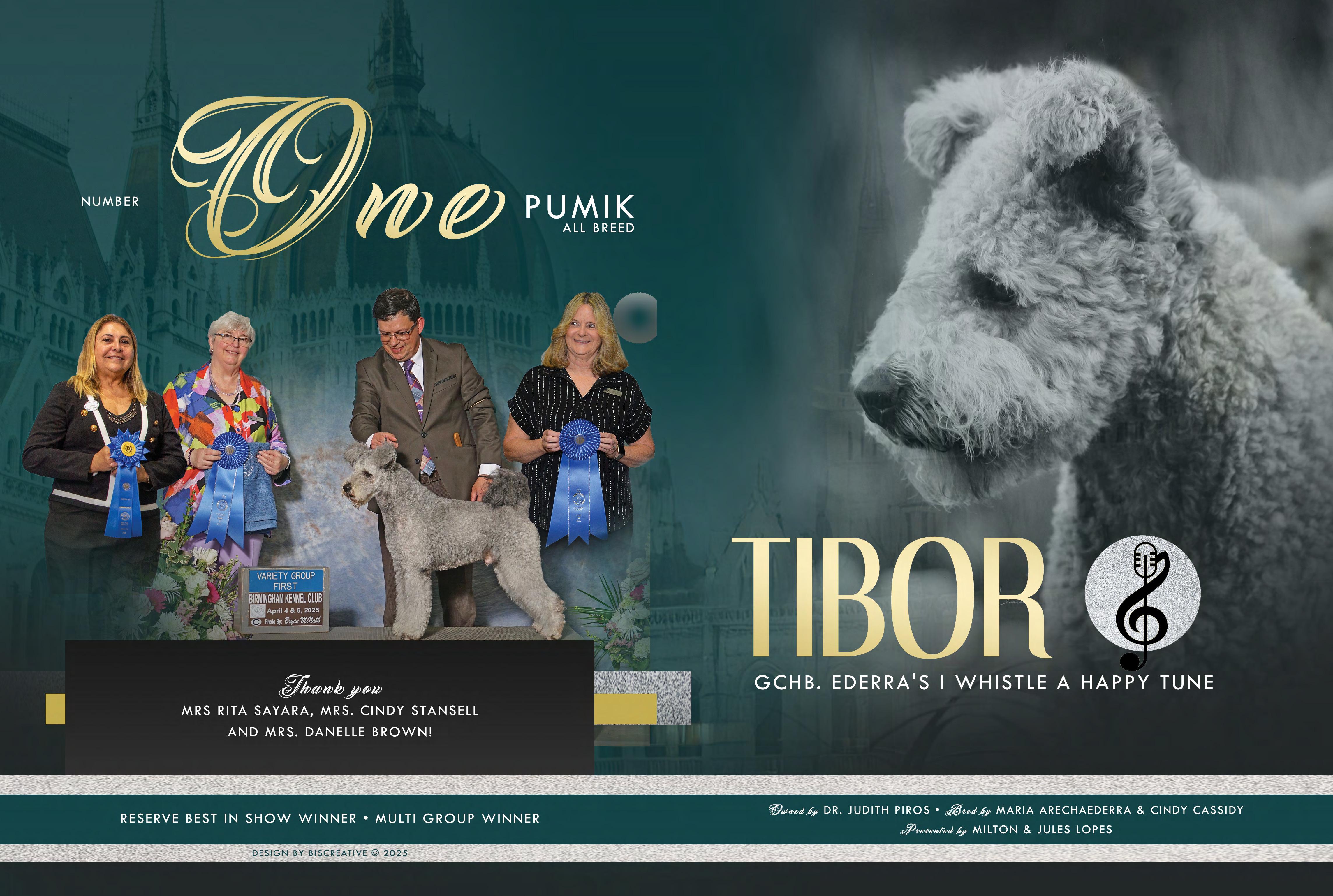


















Can you share with us how you first became involved with the world of pedigree dogs?
I’m fortunate that I was born into the sport of dogs. While I was more interested in horse shows and sports when I was younger, my grandmother, Anna Wanner, and my mother, Lynne Meeks, introduced me to the dog world. Granny Anne was an AKC judge for over 50 years andbredandshoweddogsaswell.Whenshemovedinwithmyparents,I became more interested in what dog shows were about, as I was exposed to them daily through her travels worldwide as a dog show judge. My mother purchased a Border Terrier for my brother when I was about 10 years old, which actually became my first junior showmanship dog. I showed Scout for many years in juniors until I “outgrew” her and moved on to a Doberman Pinscher, and later acquired an Airedale Terrier.

Who were the handlers who inspired you early in your career, and under whom did you begin your apprenticeship?
Being someone who learned many skills by watching others, I admired many handlers in my youth. Peter Green was one of them, with his finesse in grooming terriersandhissuccessinthering.IalsoadmiredDennis
McCoy and the care and presentation of his Poodles week in and week out. Although my grandmother was an AKC judge of almost all seven groups, and I was playing high-level competitive softball, I did not have the availability to work for many handlers. I attribute much of my apprenticeship to Tracy Szaras, Gerardo Reyes, and Mike and Linda Pitts for teaching me what they could during my junior showmanship years. After college, I moved to Maryland to work as a paralegal in Washington, DC, while also apprenticing under Sue Whaley. Through these experiences, I learned a tremendous amount about grooming, business skills, and handling—skills that I still use today.
As a handler, do you find more excitement in winning at an all-breed show or a breed-specific specialty show? Why?
There is a thrill in winning at either type of show, but from a breeder’s standpoint, I find it more exciting to win at a breed-specific specialty show. To me, it showcases that you are the best in your breed. Don’t get me wrong—a Best in Show is fantastic as well—but a big win within your breed, or a breed that you are campaigning, means more.
Does it mean more to you to have the number one dog in all breeds or the most breed points? And why?
Being the number one dog in the breed speaks volumes about the quality of what you’re showing. A dog that is number one in its breed shows that it is the best specimen in the country. While an all-breed ranking is fantastic, being highly ranked in your breed shows that your dog exemplifies the standard as it is written. I find more appreciation for a dog that is ranked higher in its breed than in all breeds overall.
Dog showing is often about comparing breeders’ future breeding stock. Do you feel that this goal is top of mind for your clients when they place a dog with you for competition? Do you think this mindset is common among dog owners who show their dogs?
Having been a handler for over 15 years, I have been fortunate to work with many breeders to showcase their breeding stock. I agree that the kennels I work with want to present the breeding stock they have in order to preserve the breed they are so passionate
about. Whether they send a dog with me to be finished or to campaign, they want their program seen so it promotes what they produce, whether through their bitches or their males. Now, do I think this is common among everyone? No, of course not. Some just want to show their dogs to their championships, rankings, etc., and they never see a whelping box or sire a litter. And that is okay. They are still contributing by showing the fancy the dog they have from whichever kennel they purchased it from, and indirectly marketing that breeding program.



Are there any particular breeds or groups of dogs that you particularly enjoy handling? What draws you to them?
Terriers are near and dear to my heart, having been involved with them since a young age. However, I enjoy showing working and sporting breeds the most. I have had the fortunate opportunity to showcase some beautiful dogs in many groups. I’m drawn to Xolos, Standard Schnauzers, and Airedales because they are breeds I can relate to on many levels and are near and dear to my heart. There is a bit of fit and flare to each of them, and their demeanors and temperaments are
enjoyable to work with each weekend. I’ve also had some once-in-a-lifetime dogs in these breeds that gave me a thrill when I showed them.
Do you work with assistants or a team?
Ifso,whatkeylessonsorskillsdoyouhopetopassonduring their time working with you?Anna Frandsen has been my live-in assistant for about a year. I have worked with many young individuals over the years as well. My goal with my assistants is first to teach them the care and husbandry requiredforeachdoginmycare.Beforetheysetfootinthe ringwithanyofmycharges,theylearnthecareofeachdog, how to handle the setup, how to properly clean the truck, what it takes to condition an animal, etc. After about six months of working with me, I give them a project dog, and it becomes their sole responsibility to care for, condition, and groom that dog. Currently, Anna has a Xoloitzcuintli that she has been preparing for our National Specialty in November.
If you could have handled any dog in history, which one would you choose, and why?
There have been many greats I would have loved to have handled,buthavinghadaGermanShorthairedPointergrow up with me and sleep under my crib as a baby, I’d choose GCH Fiedfines Back in Action. To me, he is the epitome of what a German Shorthaired Pointer should be. Ace was a four-time National Specialty winner and top producer. He commanded the ring each time he entered it. Now, in the present, I am beyond grateful to show for his handler, Dorothea Hand, by exhibiting his children, grandchildren, etc. In each one, I see this incredible dog shine through. Dot Simberlundwasagreatinthisbreed,andItrulyaspiretobe likeherandher daughter one day with our own breeding program.
Do you have the time or opportunity to breed dogs of your own? If so, what breeds do you focus on? If not, is this something you’d like to pursue more in the future?
In 2021, I was introduced to the breed of Xoloitzcuintlis through Jose Miguel Sanchez and Teresa Campbell. I have been honored to be a part of DreamStar Xoloitzcuintlis these past four years through breedings and campaigning dogs. It is a true joy to watch the puppies grow into the beautiful dogs they are today. I’m honored to have been a part of campaigning multiple #1 bitch Xoloitzcuintlis in the United States, as well as presenting our dear Itzia, GCHG DreamStar’s Water Goddess, at Crufts—winning the breed and making the cut in the group, the first ever for a Xoloitzcuintli. I am excited for our future litters and continued success with these beautiful dogs.
What are your thoughts on the number of dog shows happening each week across the country, and the level of participation in those events?
While I agree that there are an outrageous number of dog shows on some weekends and the entry numbers aren’t as great, as a handler it is nice to have more options. However, trying to finish dogs and find majors in certain breeds has become difficult when the numbers aren’t there in the classes. Even trying to rank a dog in their breed standings calls for more travel and a more hectic schedule.
How do you decide which shows to attend? Do you prioritize certain judges or consider factors like location and travel distance?
Each year requires a different strategy depending on what I have to show. I try to stick to judging panels

that will be successful for my dogs. However, I do try to keep my location choices within a reasonable driving distance or plan weekends where I can hit a show on my way out to a farther location and one on the way back. I want my dogs to be dogs and have as much time at home as possible, so being on the road for weeks is not ideal for me or my dogs. They need time at home to play and relax, so multi-week road trips are kept to a minimum.

Can you share some of your most memorable wins or achievements in your career as a handler?
My most memorable win as a handler was winning the breed and making the cut in the group at Crufts with Itzia. She was my first baby Xolo, raised in my house with Jose, and to see her progress and shine into the winner she was at Crufts makes me so proud. I will never forget hearing Teresa scream in the crowd with tears of joy. It still brings tears to my eyes today and gives me goosebumps anytime I talk about that unforgettable moment. My first Best in Show was also memorable, as it was under a judge I greatly admire and one of my grandmother’s dearest friends, Lydia Hutchinson. She awarded me Best in Show with a Standard Schnauzer bitch, Karma, at the Doswell shows. While it was already an emotional day winning my first Best in Show, I became even more moved when Mrs. Hutchinson said to me while taking the picture that my grandmother would have been so proud. I almost immediately lost it. This meant the world to me coming from her, knowing the connection she had with my grandmother.
Do you have aspirations to become a judge in the future? If so, which breeds or groups would you focus on?
My grandmother showed me throughout my childhood and later years what it was to be an AKC judge. While I havenoaspirationsinthenearfuturetobecomeajudge, I would like to pursue this role one day. The experiences she had seem to be something I’d want to include in my life. Right now, I am already a junior showmanship judge and have judged since I was 19 years old. I had the honor of judging preliminaries at Westminster Kennel Club and Royal Canin. When I begin my journey into judging, I’d like to apply for those breeds near and dear to my heart: Xoloitzcuintlis and Airedale Terriers.
In recent years, have you noticed any breeds becoming more popular or competitive? What do you think has contributed to this trend?
In my own breed, Xoloitzcuintlis, I have seen growing popularity at the shows. I think much of the increased interest is due to notable wins at major shows, as well as exposure in mainstream media. The movie Coco helped, as one of the main characters is a Xolo. Social media has also contributed significantly, as they are marketed much more heavily now than in the past.
How much time off do you typically take throughout the year, and do you think the AKC should consider adjusting show schedules to allow for more consistent vacation periods, particularly in summer and winter?
Since we as handlers dictate our own schedules, I don’t see it as necessary for shows to be structured around when we should take vacations. We all make time for breaks when needed. I tend to try to take at least a week off every five weeks; however, toward the end of the
year when we are chasing points for rankings, it doesn’t always work out that way. The Christmas holiday is when I try to take my full vacation and do something fun, as it is also my birthday right after Christmas.
If you could make any changes to the world of dog showing to improve it, what would you alter?
One thing I feel very strongly about is the rankings of juniorhandlers.Idon’tthinktheyshouldhavestandings and a ranking system. Juniors today have lost a lot of the reason why they are junior handlers and seem more focused on wins and whether they’re the #1 junior in their breed or group. When I was in juniors, it was more about camaraderie with my friends each weekend, and I feel the sportsmanship among my peers was better. I am still friends with many of the individuals I showed with years ago. I also do not believe that a junior should be able to show any dog, whether they own it or not. This loses the principle of caring for, conditioning, and training their own dog. While I understand that this helps those who do not have access to a dog, I don’t think wanting to take whatever dog won the day before into their class is right or fair.
What is your favorite way to unwind on days when you’re not working with dogs? Do you have hobbies or interests outside of the dog world?
I’ve always been an active person, having played Division I softball in college, so watching my nephew play baseball is always at the top of my list. I’m not home as often as I’d like to watch him play, but I try to attend as many games as I can. I am also an avid reader and enjoy sitting down with a good book. Time at home is quiet, even if I am with the dogs, but that is the peace my home brings me.
Do you have a favorite holiday destination or a place you like to visit to relax and recharge?
My favorite place to visit is Charleston, SC. I have been many,manytimesandalwaysthoroughlyenjoytheslow Southern way of living while there. Although I live in the South, visiting a city that was a key part of the Civil War has its unique interests and perks. Each visit brings new adventures and things I haven’t done before. From tours to shopping to nightlife, it truly has it all to relax and recharge. A close second would be Annapolis, MD in the summer. Nothing is better than Chesapeake crabs and seafood. I lived there for many years, and returning feels like coming home, with many friends who still live in the area. Sitting on the back dock at my good friend’s house watching the boats go up and down the bay is one of the most relaxing things ever.
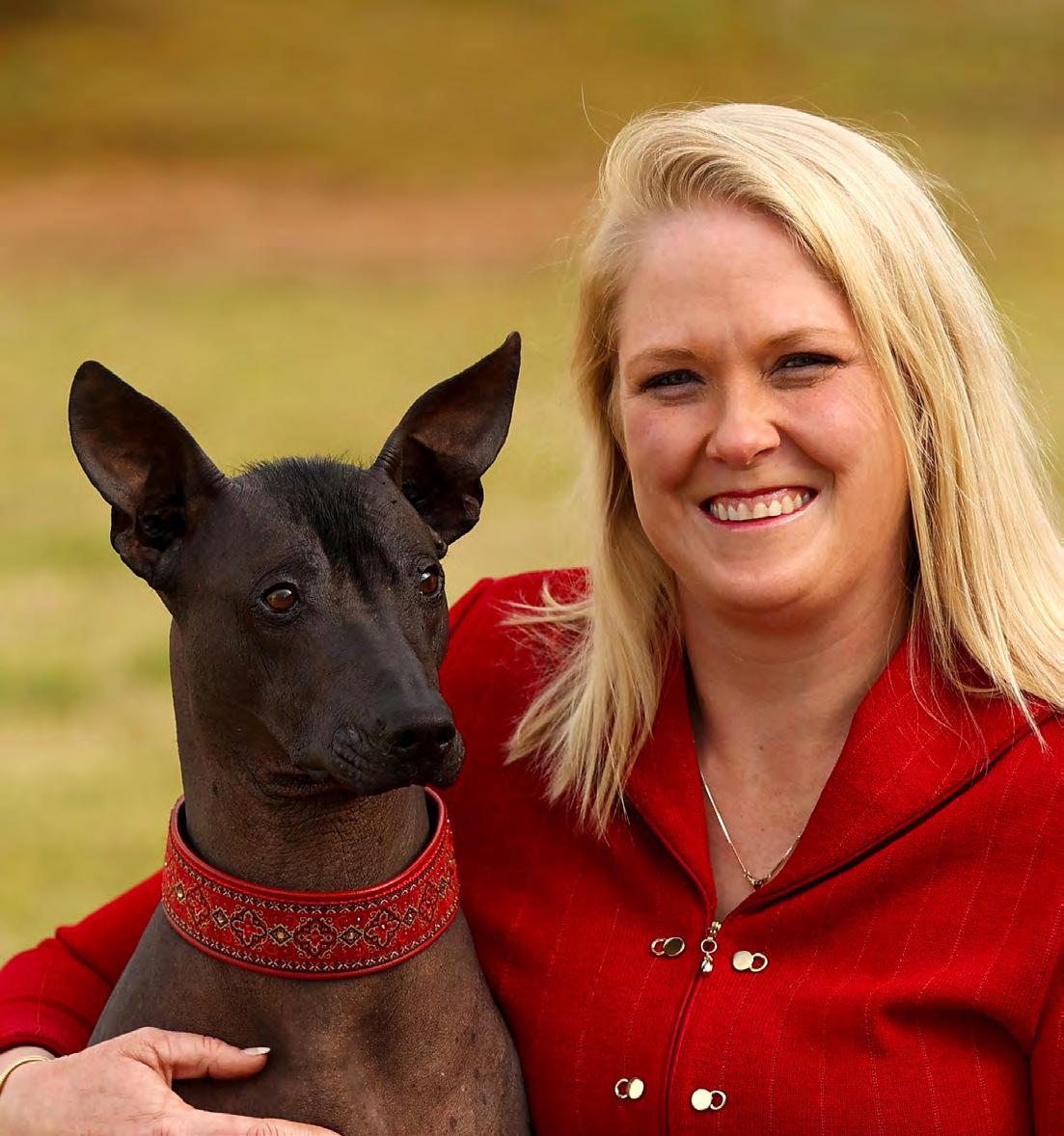








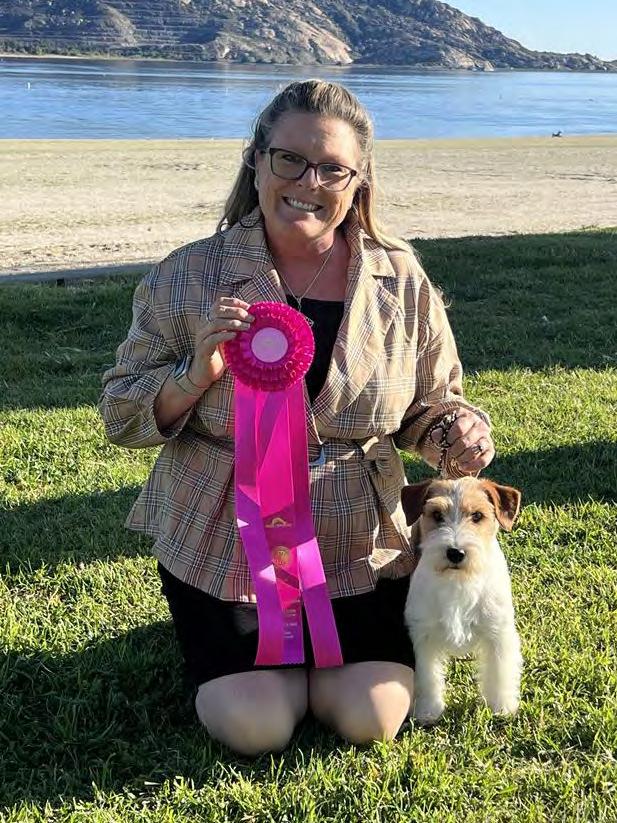

Please tell our readers how you got involved in the world of pedigree dogs and which people were the most important in your beginnings.
Aftera3-DayEventingaccidentleftmewithabrokenback,myloveofanimalsand competition shifted from horses to dogs. My first pedigree dog was a Rottweiler, and we competed in obedience, rally, and agility. I then spent 30 years in the U.S.
Jack Russell world, doing earthwork as well as other dog sports. During that time, I got my first AKC conformation dog—a beautiful Border Collie named True—who also participated in rally and agility. Fast forward: eight years ago, we wanted to add a small terrier back into our lives, which led me to research the Russell Terrier. And that’s where we are today.
What breeds of dogs have you shown over the years, and which breeds are your favorite to work with?
As a professional behavioral trainer, I work with all breeds. My favorites, though, are still the terriers—I just love their spicy nature. Off the top of my head, I have shown Russells, Border Terriers, Rat Terriers, Bedlingtons, Am Staffs, Toy Manchesters, Standard Manchesters, Coonhounds, and Border Collies. I’m sure I’m missing a breed or two from those quick trips into the ring to help a fellow owner-handler.
Where did you get your foundation dogs, and which breeders from the sport do you work with today?
Funny enough, I had a hard time getting into Russells. When I first inquired about the breed seeking education, no one would call or email me back. Thank goodness for Lynn Grimsley at Falling Branch Russell Terriers—she was the only one who took the time to talk to me and ultimately gave me a chance. She sold us our first Russell puppy, GCH CH Falling Branch A Force To Be Reckoned With. Reckon was the one who started it all. He taught me to be a good handler in a sea of professionals. After that, doors opened both in the U.S. and abroad. Monica Fonzo at All Jacks was the second person who helped us move forward in the breed. In early 2020, we imported our first girl, CH All Jacks Dixieland ATT—being 2020, that was an adventure all on its own. I will forever be grateful to Lynn and Monica for entrusting us with their lineage, which is the foundation of our program today.
Please mention some of your most successful dogs, owned or bred by you.
My most successful dog is our first bred-by, GCHS CH BreezyMeadowsWhiskeyRebellionATT—Washington…
Wash… Squash… Squishy. Yes, he has WAY too many names. He was the first male Russell to earn NOHS Platinum and is still the #1 Lifetime NOHS Dog. In 2023 he was NOHS #2 and earned an Award of Excellence at the National Championships in Orlando. In 2024, with limited showing, he finished NOHS #3. As of today, he sits at #1 for the year. He has also remained consistently in the breed’s top 12 with me as his handler since he started.
Please share with our readers some of your highlights in the show ring so far.
Washington has earned multiple OH Reserve Bests in Show, as well as regular Group placements. The overthe-top moment was when he took a Variety Group 1 over the #1 Mini Schnauzer.
What makes you more excited—winning an all-breed Best in Show or a Specialty Best in Show?
A Specialty win! Competing with the best of the best is always fun.
Do you believe there are too many all-rounder judges in your breed and not enough breed or group specialists?
I think our judges are a mixed group. In one weekend, we might show to a judge who clearly understands the breed—checking coat for layers, spanning the chest properly, and knowing the most up-to-date standard, which is often revealed when they ask to see the bite. I do wish more judges would learn to properly span, and I always appreciate one who is open to learning this skill. Coming from a hunting/ working background, lack of proper spanning is my biggest pet peeve.
Where in the world do you believe your breed has the best quality?
Honestly, Europe. The Russell has come a long way since the books first opened here in the U.S., largely due to early—and continued—imports.
Do you judge, and if not, would you like to judge someday?
I am not an AKC judge, but I would consider it. I’ve attended an Intro to AKC Judging seminar. I would especially love to be involved with the Juniors program; the kids are the future of our sport.
Is there any advice you would like to give to professional handlers, owner-handlers, and judges?
Be kind. It costs nothing to be nice to those around you—you never know who you may influence. If we want to keep the sport of conformation alive, it’s our job to help those around us, regardless of our role. To the Professional Handlers: continue giving pointers and helping others. You will be more successful, as those around you will respect both you and your skills. To the Judges: be patient. Not everyone who walks into your ring knows what they’re doing. We all had to start somewhere. To the Owner-Handlers: if you see someone new, say hi, lend encouragement, make friends outside your breed, and help each other. We can all do better.
“Be kind. It costs nothing to be nice to those around you. If we want to keep the sport of conformation alive, it’s our job to help those around us.”

What is your favorite way to unwind on days off? Any hobbies outside the dog world?
Camping! We love taking the dogs out in the Jeep and getting into nature. We also love visiting National Parks, which we often do when traveling between shows.
If you had the power to change something about dog showing for the better, what would it be?
This is the only sport I know of where professionals and amateurs directly compete against each other. I would change the politics. Judge the dogs… not up the leash.
Is there something that has recently moved you?
I have been very lucky to make great friends in the dog show world—breeders, owner-handlers, and professional handlers. I love that these people help me up my game, help me groom better, help me present myself and my dog better. They offer support even though we compete against each other regularly, whether in Breed or in Groups. For that, I am forever grateful.
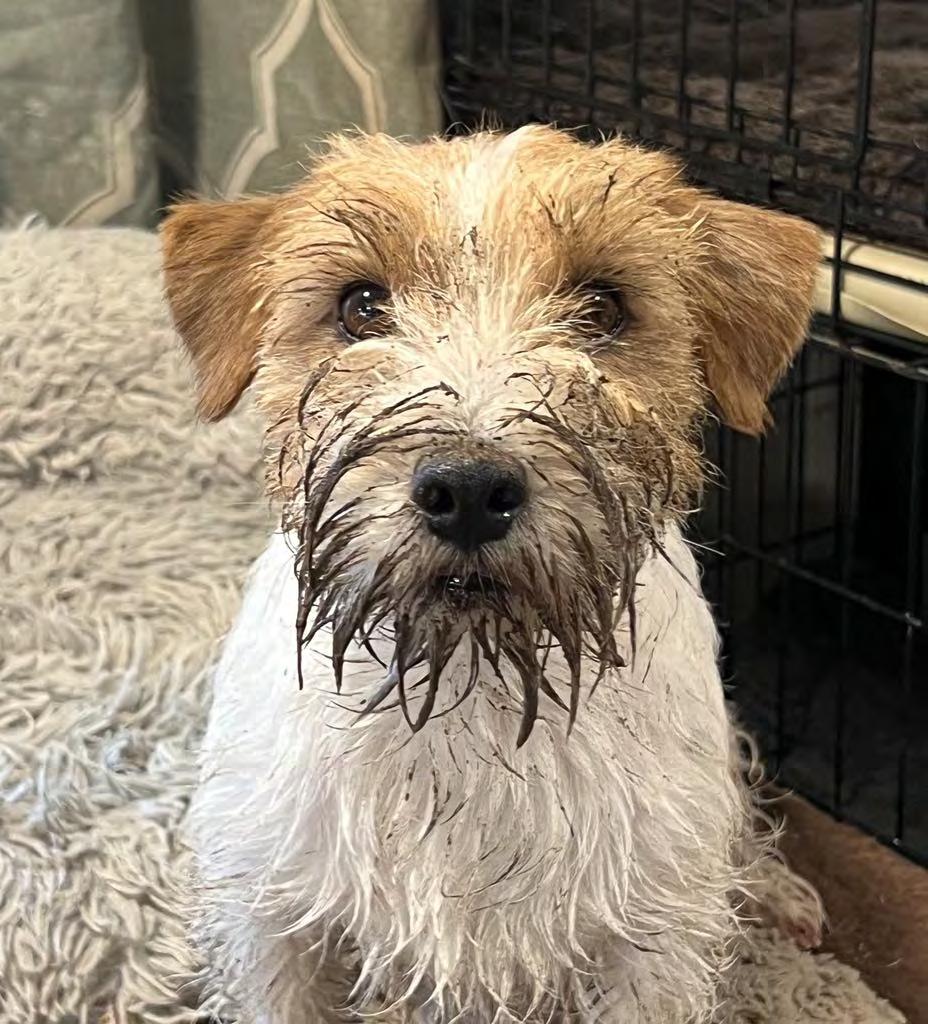

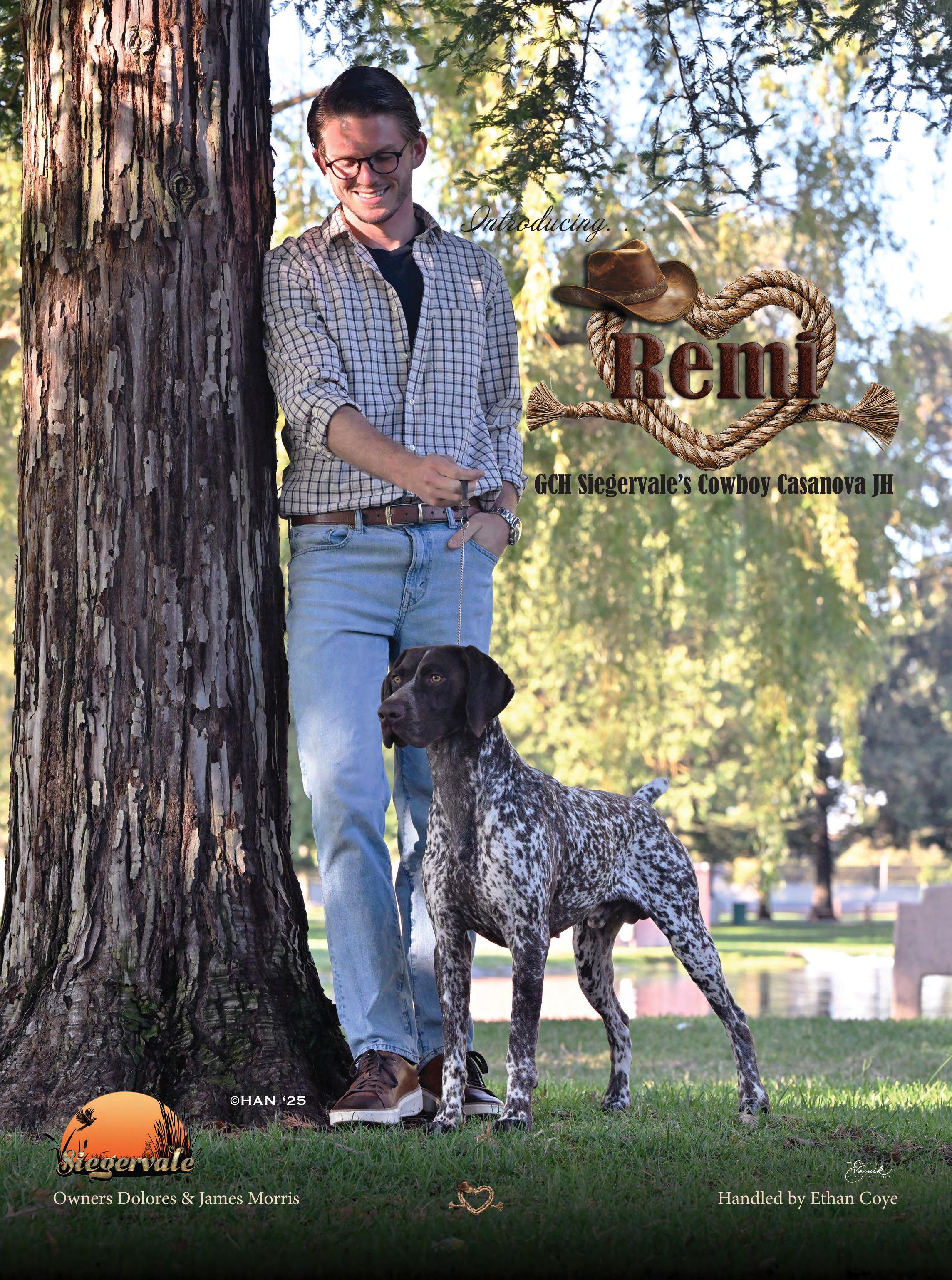




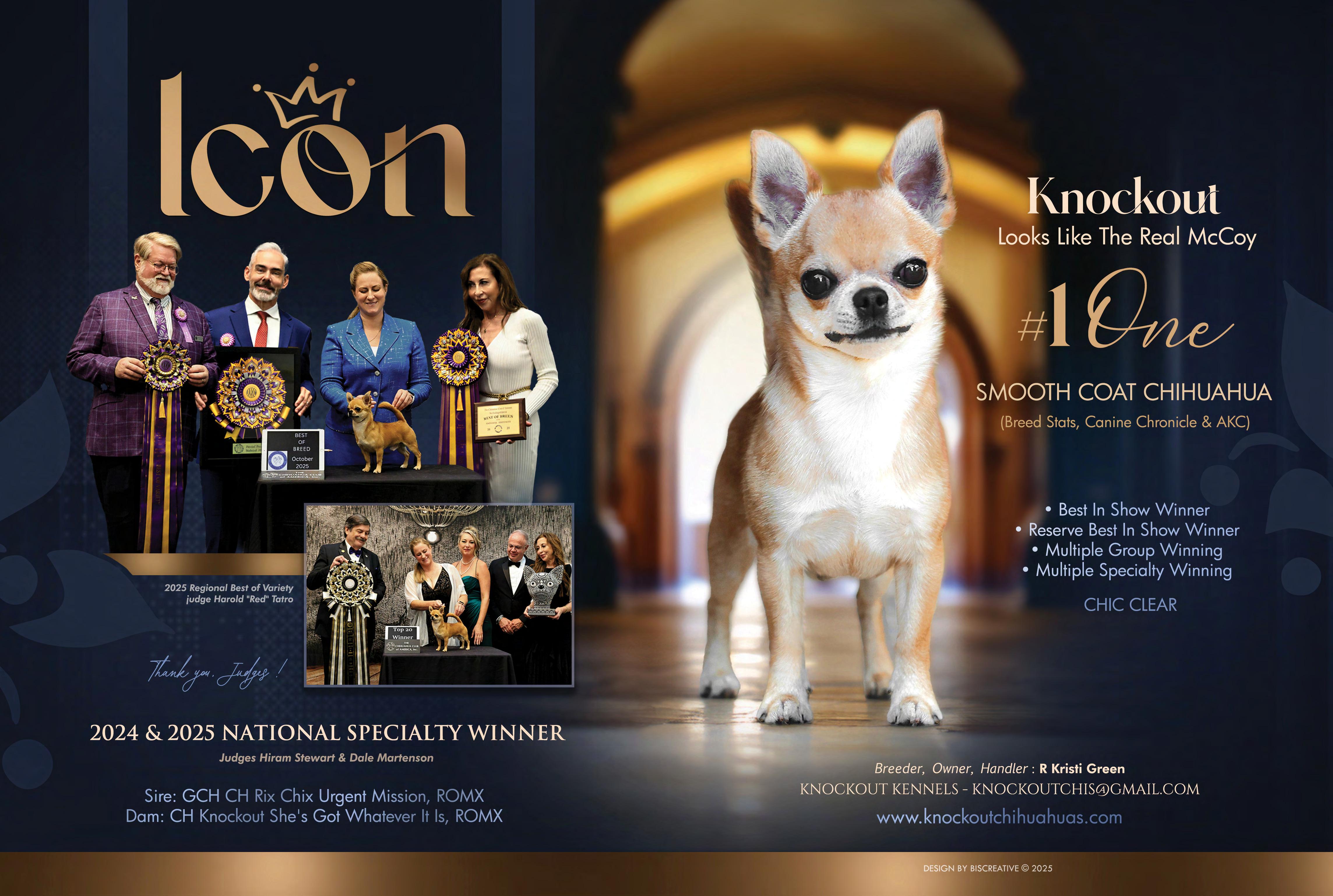






Please tell our readers how you got involved in the world of dogs and dog showing.
My mom had trained dogs for Guide Dogs of America for years, which then led her to the dog show world. However, it wasn’t until my oldest sister got involved with Junior Handling that my mom also began to partake in the world of dog shows. That, in turn, allowed me to fall in love with the same passion.
Who were your mentors from the beginning of your dog journey? Do you currently have the same or any additional mentors?
My biggest mentors have been my sister and my mom. When I decided to take showing more seriously and wanted to understand how to handle different breeds, I began learning from Adrian Hill. Adrian and her mom gifted me my first Beagle, which truly sparked my passion. From that moment on, I became deeply involved in learning how to care for, groom, and train my own junior dog from the very beginning—an experience I’ll always be grateful for.
Whatbreedorbreedshaveyoubeeninvolvedinhandling?
Luckily, through working with and assisting many handlers, I’ve had the opportunity to handle a wide variety of breeds from every group. Currently, the breeds I show most often are Standard Manchester Terriers, Golden Retrievers, and Bullmastiffs.
Do you currently breed, and is this something you see yourself doing in the future?
I am currently one of the working minds behind Everest Kennels, alongside my sisters and mom. This is somethingIseemyselfdedicatedtoforlife,asI’mdeeply passionate about my Standard Manchester Terrier breeding program and committed to continuously improving the breed. My passion has even inspired me to further my education—I am currently in school studying genetics and reproduction to expand my knowledge and strengthen my breeding program.
In your words, what is the purpose of dog shows?
The purpose of a dog show is to learn how to properly care for, groom, and present your prospect to the best of its ability, to see how your dog meets the breed standard, and to continue bettering the breed overall.


Do you find it difficult to balance personal, school, and dog show life? How do you make time to fit everything in?
Time management is definitely not an easy skill— it takes practice, patience, and self-discipline. The key is learning not to overbook yourself. As a college student, I still struggle with balancing everything, but I constantly remind myself that my education must come first. Showing dogs is a hobby I’m deeply passionate about, but at the end of the day, my education is what will allow me to continue expanding my knowledge and improving my breeding program.
What profession would you like to have as an adult?
Good question! I’m currently on the pre-vet track and preparing for veterinary school applications. However, I’m keeping an open mind about where my career path may lead me next.
Do you prefer handling table dogs or larger dogs?
I don’t know if I have a preference, but I do love showing my big dogs. There’s something about having a nice dog on the end of my leash that always allows me to show that dog to the best of its ability, whether around the ring or on the line.
Is there a certain coat you prefer to prepare for the ring?
Since I grew up with Goldens, I enjoy grooming double-coated breeds.

What professional handlers or owner-handlers inspire you?
Judy and Gary Anderson have always been a huge inspiration for me. Although I never had the chance to meet Gary, I’ve heard incredible things about his talent and dedication as both a handler and breeder. I’ve been fortunate enough to know Judy personally, and she continues to inspire my breeding program every day. I even have my foundation dog from her, which makes her impact on my journey even more special. Her deep knowledge, passion, and commitment to the breed constantly motivate me to learn and improve as a breeder.
If you could be an assistant for any handler, past or present, who would it be and what would you hope to learn from them?
I’ve been incredibly lucky to work alongside some amazing handlers who have truly shaped me into the handler I am today. One of the greatest opportunities I’ve had was working for the Fenners. They’re not only exceptional professional handlers but have also become family to me. I’ve learned so much from them over the years, and I’m forever grateful for their guidance, support, and the lessons they’ve shared with me.
What have been some of your greatest achievements in the breed ring?
Some of my biggest achievements in the breed ring began during my time as a junior handler, when I won Best of Variety at Westminster in 2019 with my Standard Manchester Terrier. That experience sparked my passion for the breed and led me to my first bredby litter. In a relatively short time as a breeder, I’ve been fortunate to achieve milestones such as Reserve Best in Show at the Breeder Showcase in Santa Barbara, producing a national winner, multiple group winners, and specialty winners, and breeding and owning the #1 Standard Manchester Terrier in all systems with my mom and sisters.
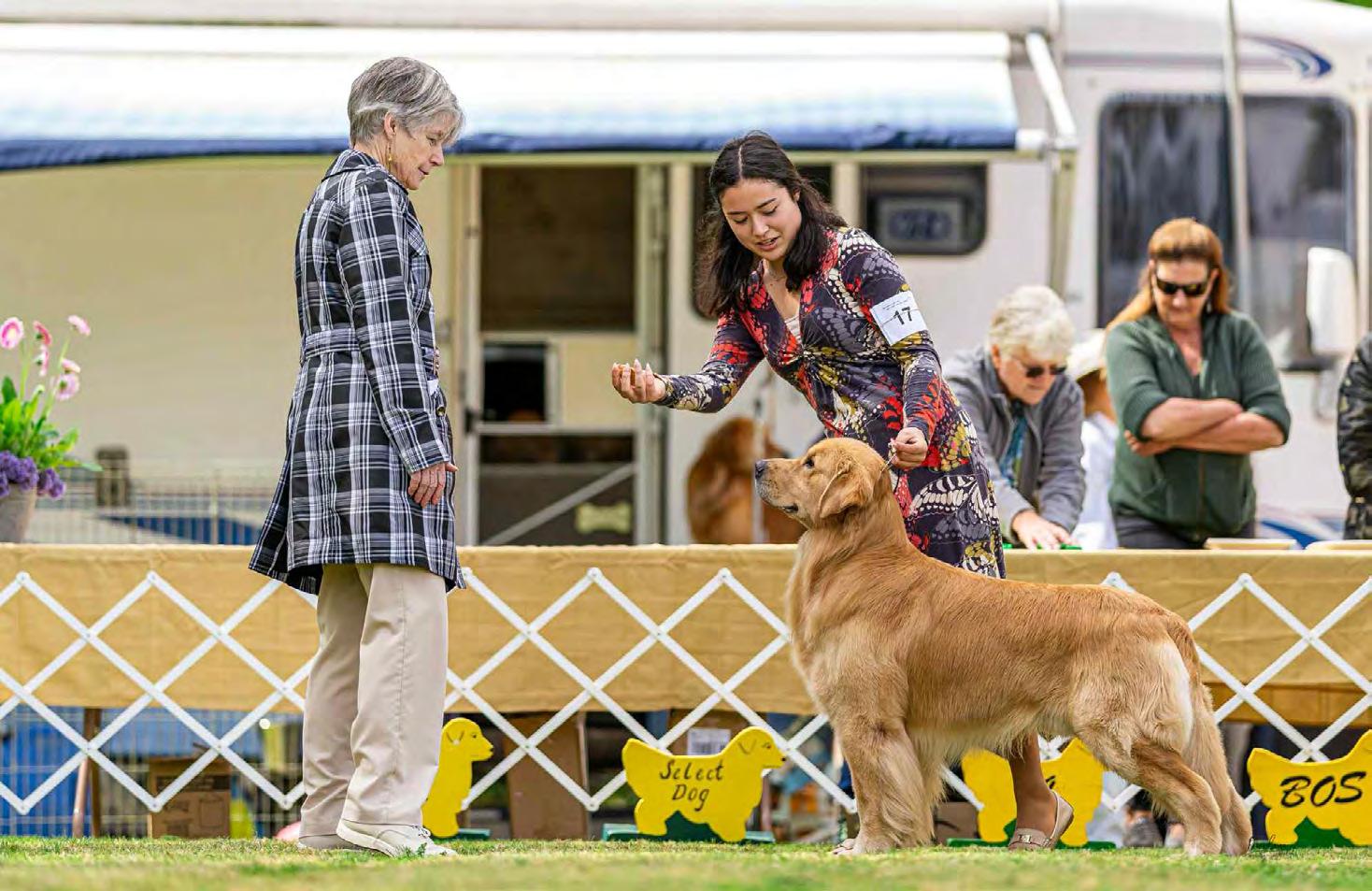
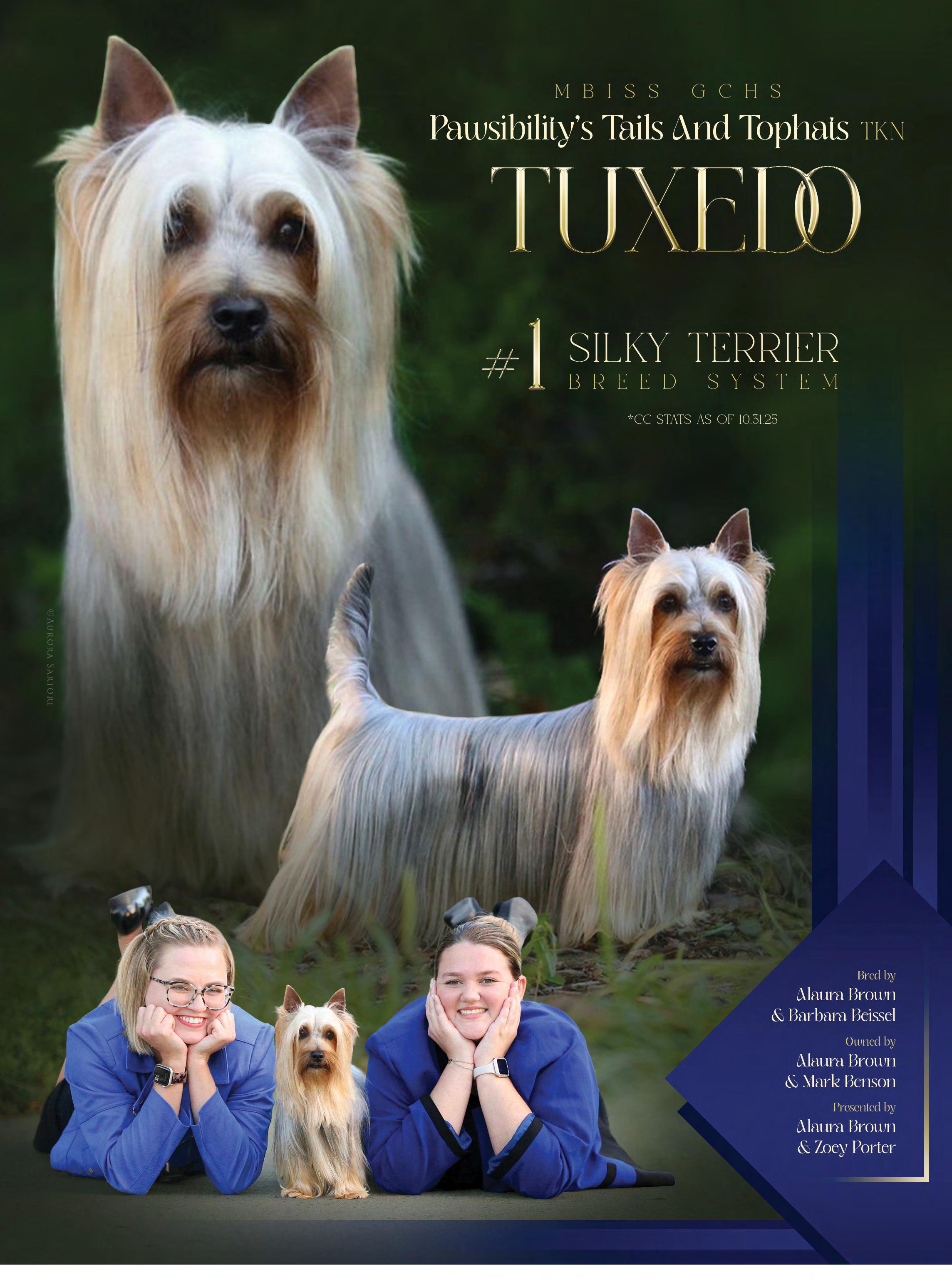

What is your favorite show of the year to attend, and why?
Westminster, of course! It’s truly an unforgettable experience. Not only is the dog show itself incredible, but it’s also a special time to connect with family and friends. Every year brings new memories and stories that make the experience even more unforgettable. Is there anything you wish judges understood more when it comes to judging Junior Showmanship?
I hope judges understand that each breed is shown differently. Juniors shouldn’t focus on what the judge prefers, but rather on presenting their dog to the best of its breed standard. At the end of the day, Junior Showmanship is about how the junior handles their dog in the ring, showcasing the dog to its fullest potential.
Do you have any pastimes outside of the world of dogs?
Though dogs take up most of my life, my other passion lies in preparing for school and extracurricular activities.
What are your own personal future goals in the world of dogs?
My current goals are to complete my education and pursue a career that truly sparks my passion, while continuing my breeding program as a meaningful hobby. I hope to keep improving the Standard Manchester Terrier breed—not only in the conformation ring but also through various dog sports. Above all, I want to continue advocating for my breed and sharing my passion for them with the world. INTERVIEW







By Bo Bengston
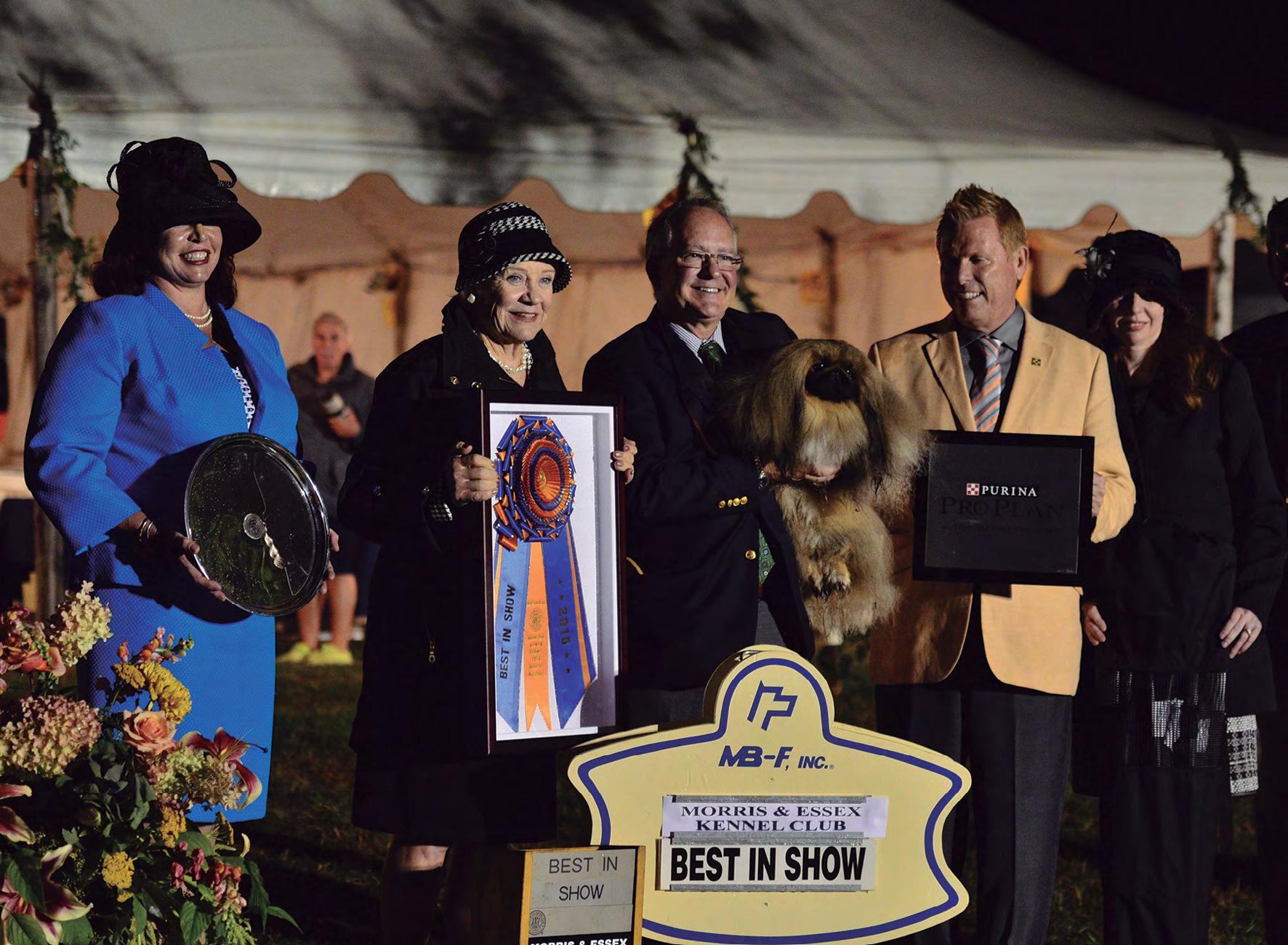
Originally published by Dogs in Review in 2015.
It was one of the greatest dog shows ever held in the United States. Even Mrs. Dodge, the great lady who created Morris & Essex Kennel Club almost a century ago, would have been impressed. Although she was, of course, not present in person, I suspect that most of us felt her spirit pervade nearly every aspect of the event.
This year’s Morris & Essex Kennel Club show was only thefourthoneheldsincethisfamousoldclubwasreborn after many years of being just a memory. Now held only once every five years, the 2015 show was the first for the club since 2010. Again it took place at Colonial Park in Somerset, New Jersey. The date, October 1st, 2015, was a Thursday, — not usually the ideal day for holding a huge dog show.
Nevertheless, there was an entry of 4,152 dogs making 4,666 entries, among the highest figures reached for a dog show in the U.S. According to AKC’s event statistics a total of 3,561 dogs were present and competing; the weather probably accounted for more absentees than
usual, but that total still makes this one of the largest AKC shows in more than a decade. (Last year’s AKC/ Eukanuba show in Florida in December had a few dozen fewer dogs in competition than this M&EKC; this year’s show, a few weeks after Morris & Essex, turned out to be even bigger.) The Kennel Club of Palm Springs in California has had entries as big as M&E, but you have to go back to the Louisville weekend in 2004 to find a show that actually had more dogs on view than this one.
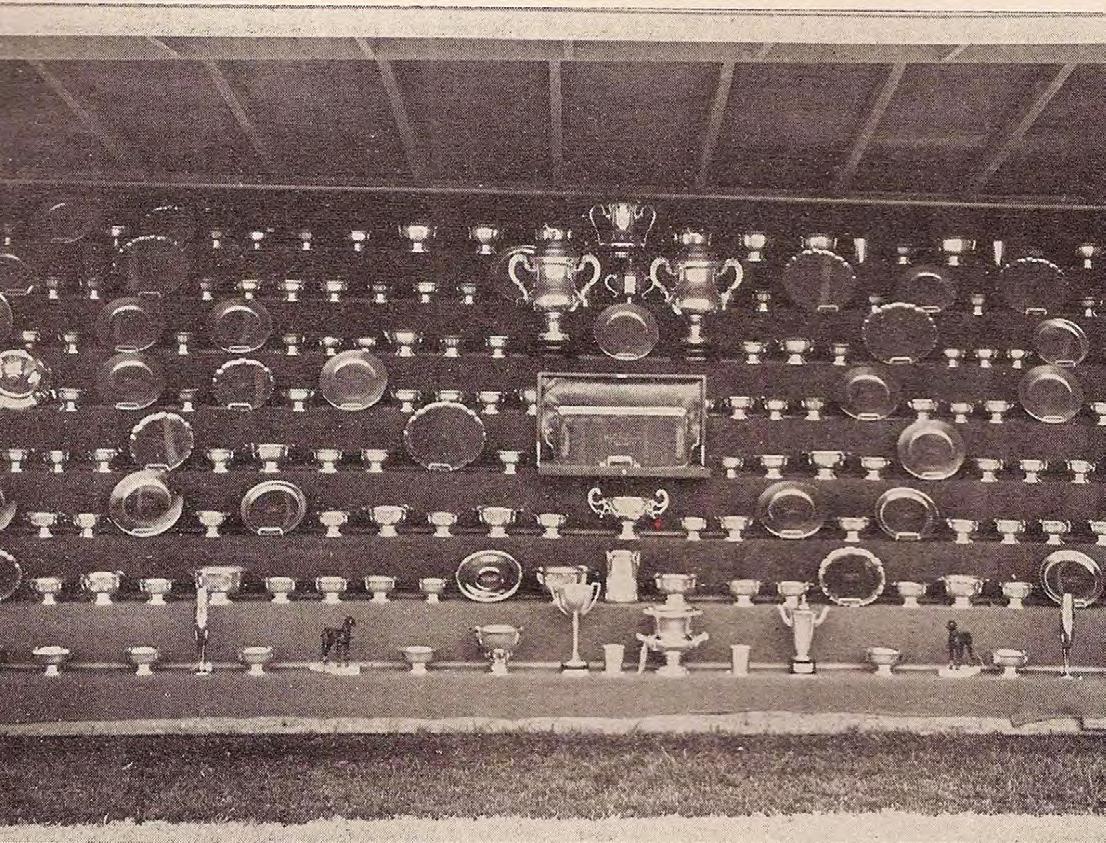



Other figures: There were 121 judges for 189 breeds, including 44 sweepstakes assignments, incorporating 32 specialties and 89 supported entries in 29 rings with 46 ring stewards. There were 1,870 feet of tenting (more than a third of a mile!), three mega-power generators providing electricity and 2.3 miles of electric cable, eliminating the need for private generators for grooming. In addition to 3,000 regular parking spaces there were 425 RV spaces and 45 golf carts shuttling visitors from the parking lots to the show. The immediate show grounds are 20 acres; Colonial Park is approx. 2 square miles.
There was a catalog of 568 pages; just the exhibitors’ index covered more than 50 pages in fine print. The premium list of 81 pages was reportedly the largest ever presented. Exactly 189 silver-plated Revere bowls were awarded, one to every BOB winner, as well as 700 rosettes and countless other trophies donated by
supporting clubs and individuals in the various breed classes. Serious silverware was offered for Group placements and BIS, and Purina Pro-Plan, the event’s official sponsor, donated various items to all Group and Breed winners, as well as to every Puppy class winner in every breed!
Most importantly, throughout the day there was a spirit of good cheer, cameraderie and sincere enjoyment of the sport of purebred dogs that isn’t common at allbreed shows these days. It must have been tough to live up to the expectations that we writers in the dog press have created, and it’s even more difficult to do this when you hold the show only once every five years — but I think Morris & Essex Kennel Club succeeded admirably against almost overwhelming odds.
So what’s the big deal, you ask? What’s so special about Morris & Essex Kennel Club? Most people know the history by now, but let me briefly reiterate it for the uninitiated. One of America’s wealthiest women in the first part of the 20th century, Geraldine Rockefeller Dodge, was an avid dog fancier and owned the luxurious Giralda kennels, situated on her 550-acre estate in Madison, New Jersey. (Her husband, Marcellus Dodge, raised horses on a separate, even larger, adjoining parcel.) At its height there were as many as 150 dogs at Giralda, including scores of champion German Shepherd Dogs, Pointers, Beagles, Bloodhounds, Cocker Spaniels and other breeds. Mrs. Dodge won Best in Show at Westminster twice, in 1932 with the Pointer Ch. Nancolleth Markable and in 1939 with the Doberman Ch. Ferry v. Rauhfelsen of Giralda, imported from England and Germany, respectively. She also judged
BIS at Westminster, the first woman to do so singlehandedly, putting up the Airedale Terrier Ch. Warland Protector of Shelterock in 1933.
In the 1920s Mrs. Dodge began to invite dog fanciers to Giralda for what would today be described as a breed seminar. There was no “show” per se, but a number of the country’s top dogs of her then-favorite breed, the German Shepherd Dog, were invited to go through their paces on Mrs. Dodge’s immaculate, vast lawn in front of a select group of breed specialists. Spirited discussion about breed points and ideal type would ensue. By 1927 theseinformalget-togethershaddevelopedintoanAKCrecognized dog show, although still limited to just those breeds that Mrs. Dodge personally felt would appreciate her patronage. The first year 595 dogs were entered, but word soon spread of the beauty of the show, the excellence of the arrangements, the interesting judges, and Mrs. Dodge’s hospitality. (Traditionally, at precisely 12:00 noon all judging stopped and every exhibitor was treated to lunch, courtesy of Mrs. Dodge.) By 1935 more than 3,000 dogs were entered, and a peak was reached in 1939 when the famous Cocker Spaniel Ch. My Own Brucie won BIS over 4,456 dogs. (The show report that year makes it clear that this figure denotes the number of dogs entered, not the number of “entries,” which may of course be higher if some dogs compete in multiple classes.) The shows at Mrs. Dodge’s estate could without any exaggeration be said to be the event of the summer season for dog people, outstripping all others for size and elegance, even becoming recognized as the world’s largest of its kind.
After a five-year break during World War II, the Morris & Essex show returned in 1947 and was still going strong ten years later. In 1958, however, Mrs. Dodge
encountered resistance from AKC. There are conflicting stories of exactly what transpired, but the upshot was that Mrs. Dodge cancelled the show for good and instead focused on her shelter for homeless dogs. Two years after her death in 1973, Sotheby’s in New York auctioned off 2,000 of Mrs. Dodge’s personal items, mostly dog-related (“from jewels to junk,” according to pressaccounts),raisingmorethan$5millionforherdog shelter. Mrs. Dodge’s entire estate ran into hundreds of millions.
By the end of the 1900s Morris & Essex was becoming a faded but beautiful memory. However, one individual hadthebrilliantideaofrevitalizingtheclubandholding a show in the spirit of Mrs. Dodge. Wayne Ferguson

managed to gather a core group of enthusiasts behind this thought, and in 2000 the first “modern” M&EKC show was held in Madison, New Jersey, on the grounds whereMrs.Dodge’sestateusedtobe.Theshowattracted 2,992 dogs making 3,223 entries and was a huge success.
It was impossible for a “new” club to get a weekend date in the already over-crowded AKC show calendar, even for a show as prestige-laden as Morris & Essex, particularly since it was soon determined that a show this special could be held only once every five years. Wisely, therefore, it was decided to hold M&EKC on the Thursday before two of the East Coast’s most wellestablished shows, Hatboro and Devon, with the worldfamous Terrier extravaganza that is Montgomery County concluding the weekend. With Hatboro now holding two all-breed shows — one on Wednesday before M&EKC and one the day after — I was grateful I did not have to show (or groom) Terriers for five days in a row: it would have been truly exhausting. Of course, since the Devon show on Saturday was cancelled due to the ungodly weather, even the Terrier people got a day of rest. The huge Terrier entries certainly helped the all-breed shows, with the Terrier group having several hundred more entries than any other at M&E.
Not surprisingly, several Terrier breeds were among those with 50 or more dogs entered: West Highland White Terrier 86, Soft-Coated Wheaten Terrier and Kerry Blue Terriers 79 each, Border Terriers 78, English Springer Spaniels and Cairn Terriers 73 each, Norwich Terriers 68, Miniature Schnauzers 67, Scottish Terriers 64, Airedale Terriers 63, Newfoundlands 61, Rhodesian Ridgebacks 59, Flat-Coated Retrievers and Labrador Retrievers 56 each, Pomeranians 54 and English Cocker

Spaniels 52 dogs entered. At least another 15 breeds had 40-49 dogs, but there were also a few inexplicably low figures: How could there be a record 19 specimens of the Cirneco dell’Etna entered, a breed most American dog fanciers still can’t recognize (think miniature Pharaoh Hound!), but only six Alaskan Malamutes, a single St. Bernard, seven Toy Poodles, three Shih Tzu, three Chow Chows, five Lhasa Apsos, just one Australian Cattle Dog and 12 German Shepherds?
One could sympathize with the longcoated Toy dog exhibitors: An outdoor show in October isn’t the best place to show off your grooming skills. The weather didn’t help. It started out cold and windy, improved during the day, but as the second Group was going into the ring the rain started to fall, and soon ringside was a sea of umbrellas. It says a lot for the enthusiasm of the spectators that very few left: Ringside was crowded throughout, and the huge tent that provided both shelter and sustenance, as per the superb M&E
hospitality, was probably not the only reason so many stuck around. Having Dave Frei as announcer was another genius stroke: his dulcet tones have graced Westminster for years now and lend an immediate air of authority to any event.
There are so many other wonderful things that deserve to be mentioned. There was the art show, with seven “group winners” and a check for $1,000 to Best in Show. The judge was William Secord, world-renowned authority on dog painting and founding director of The Dog Museum of America. His winner was Christine Dabba’s wonderful rendition of a French Bulldog, “Frenchie.” There were the stylish period outfits worn by some fashion-conscious exhibitors and judges, and the fantasy outfits that others created. There was a magnificent trophy display that can be matched by no other show that I know of, and the unique historical

artifacts that would do any club proud. There was the Group trophy from Morris & Essex 1951, won by the immortal Boxer Ch. Bang Away of Sirrah Crest, displayed courtesy of the Boxer Heritage Foundation. (Bang Away never won BIS at M&E, but his daughter Ch. Baroque of Quality Hill did, in 1955.) There was the superb luncheon for judges and officials and 4,152 free “box lunches” — one for every single exhibitor …
So what could be improved? Don’t expect me to be impartial: I have always been a strong supporter of this show’s historical importance and emphasis on a bygone era — but of course there were some things that didn’t work as perfectly as one could have wished. That it took almost an hour to get into the show in the morning was probably unavoidable: The roads leading into the park aren’t designed for this much traffic, and apparently an additional delay was caused by a fallen tree. Personally I didn’t have any problems with that; if you go to a show with more than 4,000 dogs entered in one day you can’t expect parking to be as easy as at an 800-dog event, but
there were some frayed nerves, even though judging was postponed by half an hour.
EVEN MRS. DODGE WOULD HAVE BEEN IMPRESSED
Not surprisingly, a lot of the country’s top dogs were competinginthefinales.Exhibitorscamefrom50states, but three of the leading contenders were conspicuous by their absence: The German Shepherd bitch who’s an easy leader for Top Dog All Breeds and the Skye Terrier who is top Terrier were not entered, reportedly due to conflicts with judging interests. The Brittany who’s top Sporting Dog was not entered either; I have no idea why. Two of the other top all-breed contenders, the Pomeranian and the Whippet, both won BOB and placed in their respective Group.
The responsibility to judge BIS was originally meant to have fallen on Jane Forsyth, the legendary ex-handler and judge who with her husband, Bob, won and judged atmoreshowsthanmostforseveraldecades.Bobjudged BIS at the previous Morris & Essex show, so it seemed
appropriate that his wife would do the same thing now. Sadly, Jane died only a couple of months before the show, but she was represented during the Best in Show presentation by her daughter Sioux Forsyth-Green.
Mrs. Forsyth’s replacement was Dorothy Collier, herself a past top breeder, handler and Westminster BIS judge. She had an impressive line-up to choose from: all seven Group winners are multiple all-breed BIS winners. There was the German Shorthaired Pointer, not heavily specialled but with top wins at some major California shows to his credit. The Black and Tan Coonhound was a new face to me but is among the top Hounds. The Doberman Pinscher won her breed’s heavily contested national specialty and has won a whole bunch of allbreed BIS as well, while the Scottish Terrier is a Top 10 contender among all breeds. The French Bulldog, although U.S. bred and owned, has been successful at both FCI World Shows and in America, while the Bouvier des Flandres comes from Canada but has won the U.S. national and is currently one of the top Herding dogs in America.
But it was the Pekingese who won. If that came as a surprise to some, it’s probably because we don’t tend to think of coated Toy dogs as winning rainy outdoor shows. As anyone who knows Pekingese will tell you, they are extremely tough dogs, however: GCh. Pequest General Tso didn’t seem at all intimidated by the elements. He now has 38 BIS to his credit and was both shown and bred by David Fitzpatrick, who also co-owns him with Nancy H. Shapland.
Another reason we may not have expected a Pekingese to win would be that history seldom repeats itself to such a degree. David won BIS at the latest Morris &

Essex KC show five years ago with another Pekingese, General’s grandsire (and great-grandsire) Ch. Palacegarden Malachy, the English import that also won BIS at Westminster in 2012. David’s No. 1 All Breeds dog of 2005, Ch. Yakee If Only, is also in the pedigree, as are several generations of Pequest bitches — and, as a curiosity, even a great-grandsire who carried the SalilynkennelnamethatwasfamousinEnglishSpringer Spaniels. I bet you didn’t know there were some Salilyn Pekingese also!
Reserve BIS went to the wonderfully extrovert German Shorthaired Pointer, GCh. VJK-Myst Garbonita’s California Journey, superbly handled by Valerie Atkinson, who is also co-breeder and co-owner. Valerie shows many breeds but it’s no secret that the German Shorthairsareher“first”breed.ThisoneIcangenuinely say I have admired from the start — I remember being impressed by him when he was a baby puppy of barely three months old.
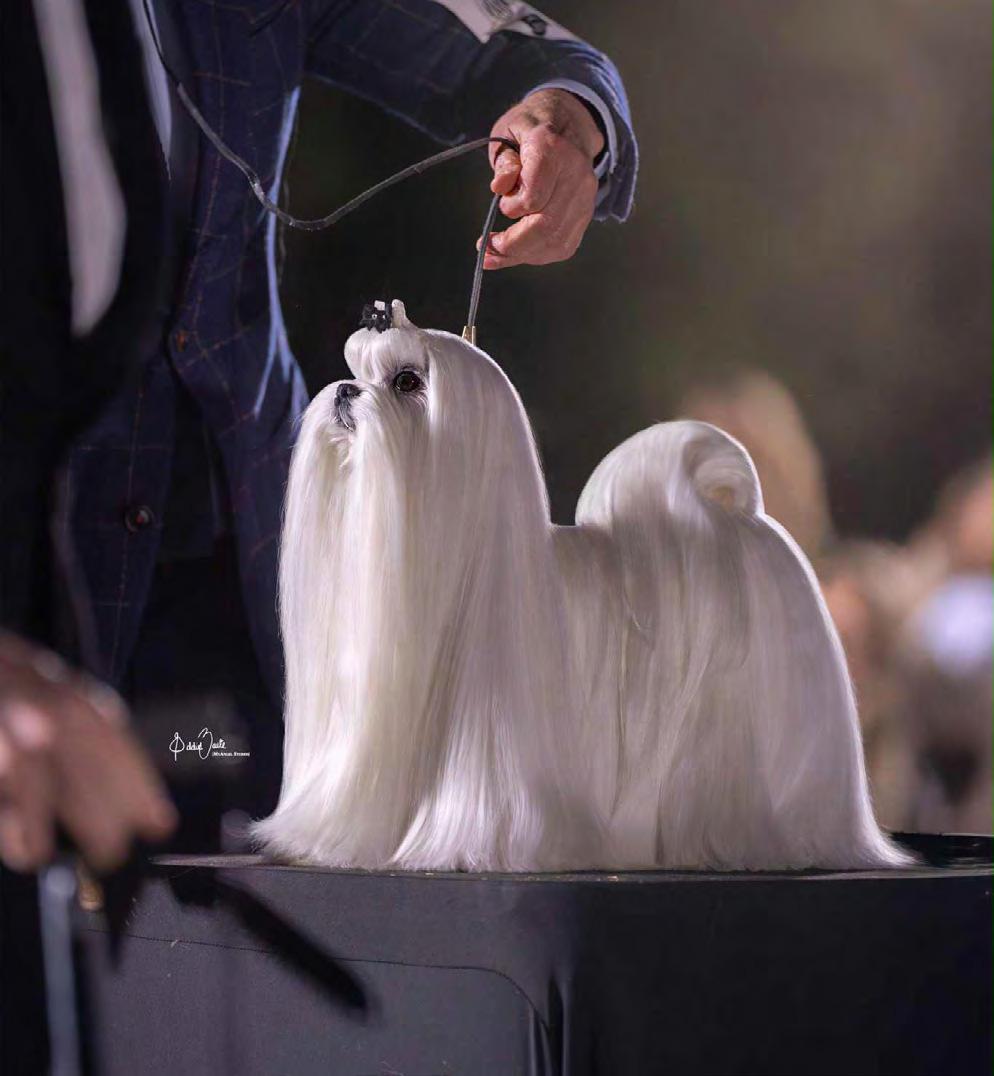








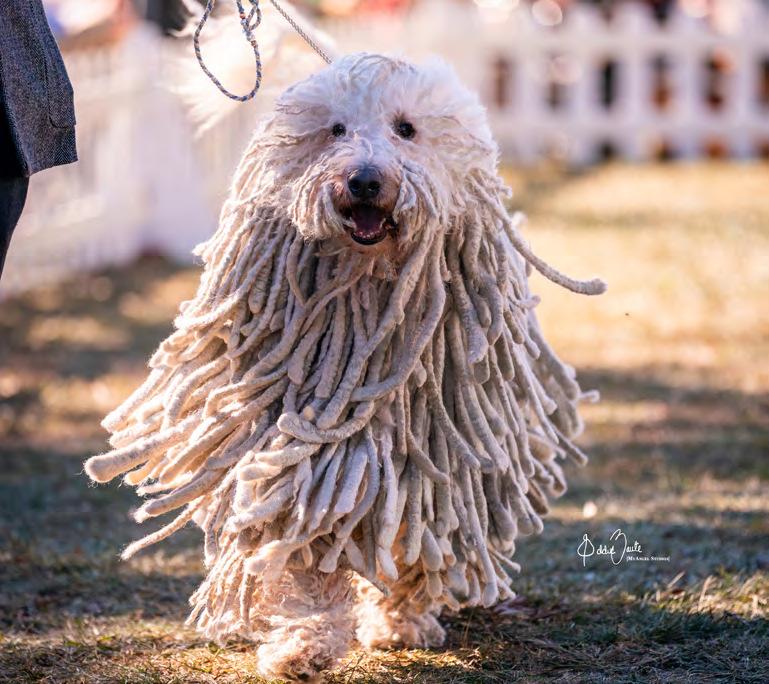
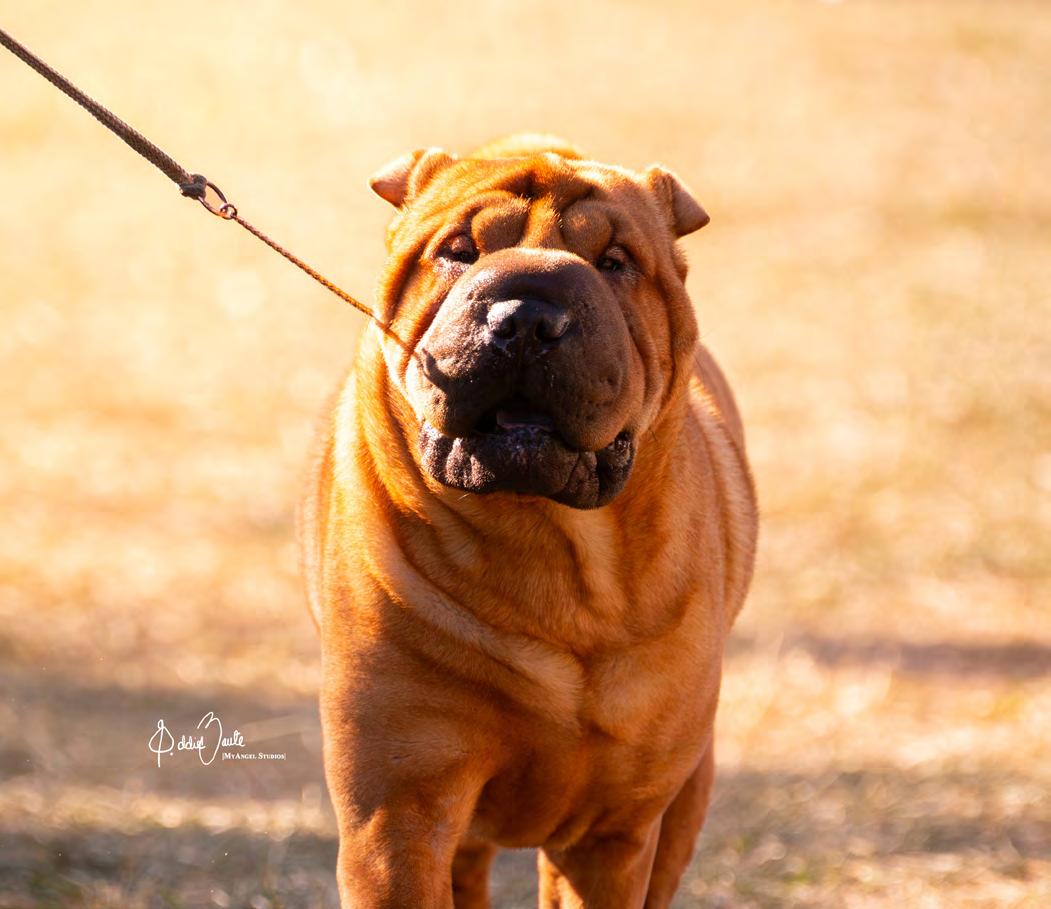
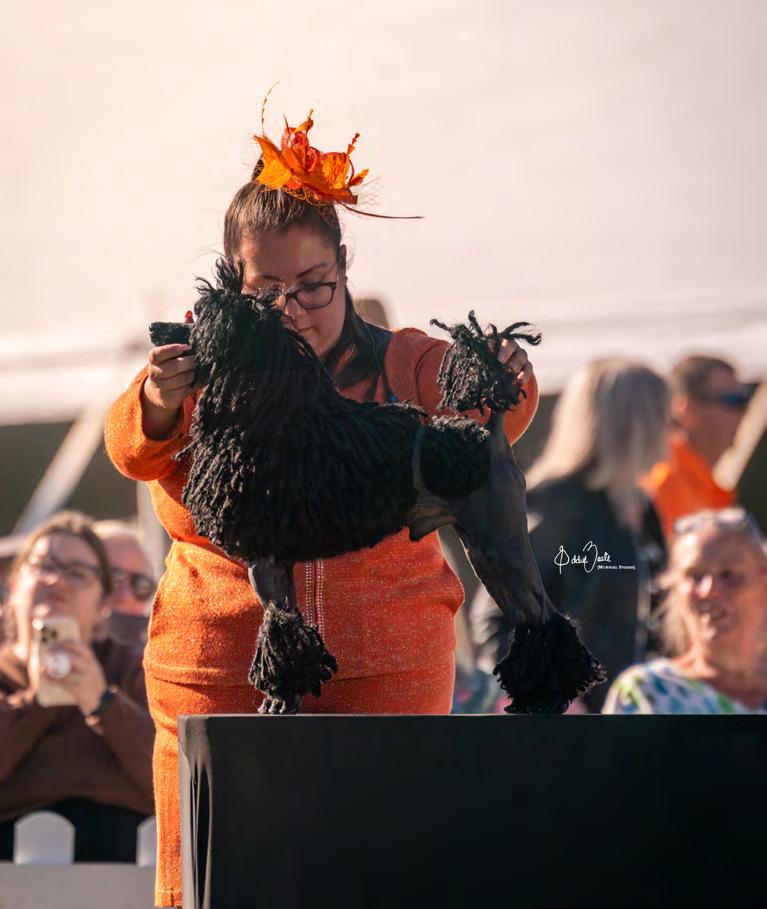
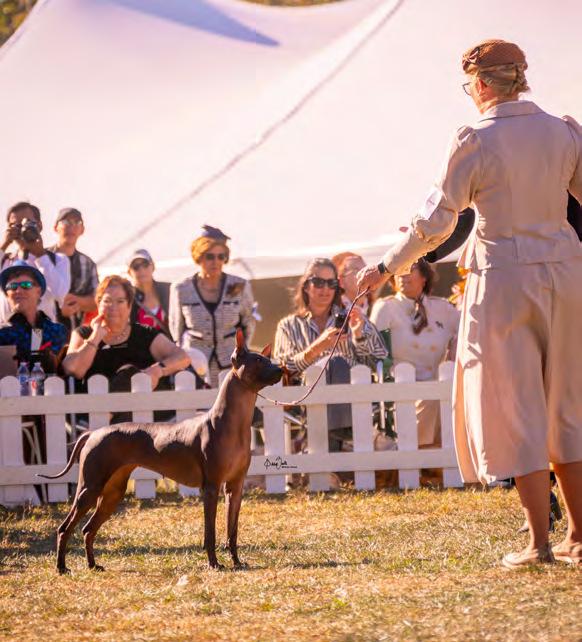


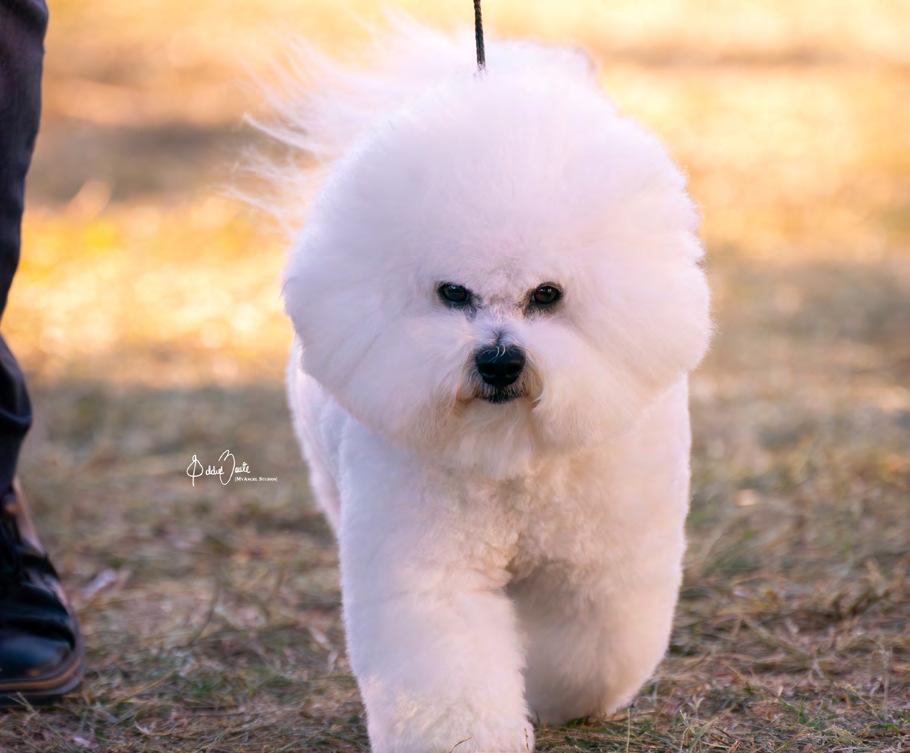

#1 - GCHG CH REJOICES TO THE POINT
Breed: Spaniels (Cocker) Black
Owner: Joy E Stevens
Breeder: Joy E Stevens
#2 - GCHB POOLE’S IDE BY DESIGN
Breed: Spaniels (Irish Water)
Owner: Gregory M Siner & Stephanie O’Reilly
Breeder: Gregory M Siner & Hannah Loonsk & Bethany Urban
#1- GCHS LOST HERITAGE TIME BANDIT AT KIARRY
Breed: American Foxhounds
Owner: E. Charles & BJ Whitlow & A. Moulton & Lisa Miller.
Breeder: Stephen Grossman & Kristin Lawless & Cole Vanover
#2 - GCH CH LAMIUELLE JP AURORA’S AMAZING MEI
Breed: Saluki
Owner: Akiko Iwakiri & Julie Lynn Mueller.
Breeder: Akiko Iwakiri.
#1 - GCHP CH ODYSEA IT’S ALWAYS SONNY AT SURFARI
Breed: Portuguese Water Dog
Owner: Dr W. & Tina A Truesdale & Charles & Lynda McCallum.
Breeder: Martha J Thomas.
#2- GCH CH CONNQUEST BEST OF BOTH WORLDS
Breed: Doberman Pinscher
Owner: F. & D. Sparagna & T. Connors-Chan & G. Chan
Breeder: Theresa Connors-Chan & Gregory Chan.
#1- GCH CH AIMHI SIDE BET
Breed: Fox Terriers (Smooth)
Owner: Amy Rutherford & Barbara Miller & Peter Holson.
Breeder: Amy Rutherford.
#2- GCHSCHSPINDLETOP’SCOURTESYOFTHERED,WHITEANDBLUE
Breed: Airedale Terrier
Owner: A Barlow
Breeder: A Barlow
#3- GCHG CH STELOR’S ROCK SOLID TKN CGCA
Breed: Pointers (German Shorthaired)
Owner: A. Partridge & L. Estes & D. Stelmach & M. Hungerford
Breeder: Dee Stelmach & Melissa Hungerford
#4- GCHG CH KASKA’S MEANT TO BE CGC TKN
Breed: Setters (English)
Owner: Donnah Brnger & Lindsey Cook & Lee Gancer
Breeder: Lindsey Cook & Lee Gancer & Mary Coldiron
#3 - GCH CHASE FARM ZIGGY STARDUST
Breed: Scottish Deerhounds
Owner: Johanna Hanson.
Breeder: Johanna Hanson.
#4 - GCH CH QUIET CREEK’S HOT TODDY
Breed: Bloodhounds
Owner: Susan Lacroix Hamil & Bruce Schultz & Tara Schultz.
Breeder: S. LaCroix Hamil & Bruce Schultz & Tara Schultz.
#3- GCHS BRAVADO’S LEAVE THE GUN, TAKE THE CANNOLI
Breed: Cane Corso
Owner: Owner: Dave Musto, Sunbury.
Breeder: Dave Musto & Alyssa Rene Marie Soldavini.
#4 - GCHG CH PEBBLES’ RUN KING GEORGE
Breed: Samoyed
Owner: Amy & A. Green & Barbara Bruns & Wolfgang Stamp.
Breeder: Amy Kiell Green & Lisa Karen Krist.
#3- GCHB CH CHYSCOTT’S THE DARK HORSE
Breed: Scottish Terrier
Owner: P Malvar & K Simmons & W & L Shafer & L Gerstner & R Hess & P Jaruthavee. Breeder: Kristen Simmons & Larae
Shafer & Whitney Jean Shafer.
#4- GCHG CH PEGFIELD TINTERN TICKLED PINK
Breed: Sealyham Terrier
Owner: G Franckowiak & P Browne & H Sutliff III & P
Harbison & C Jennings. Breeder: S W Sweatt & C V Secher & C L Jennings & H Sutliff III & P Browne.



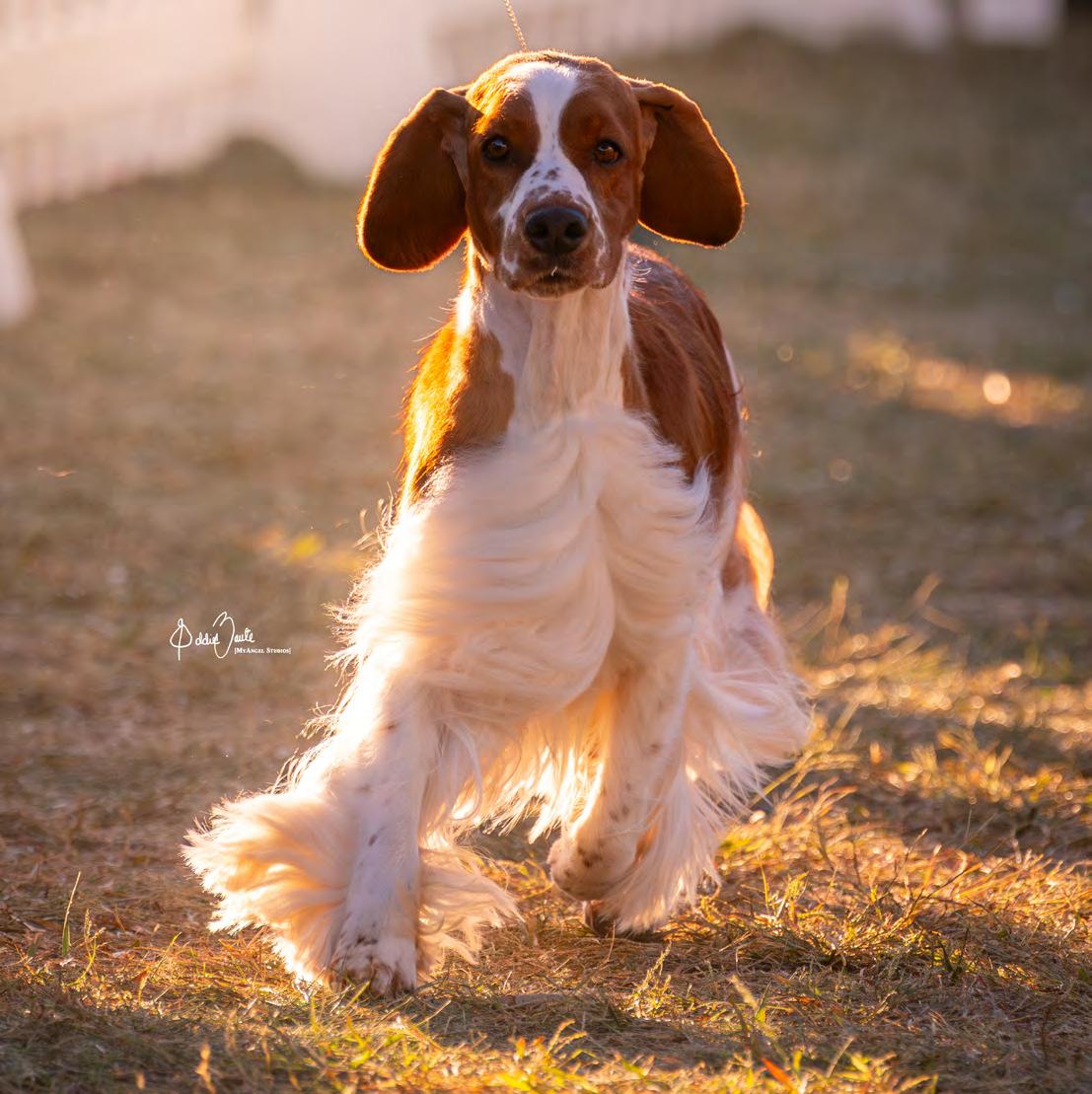
#1- GCHB CH TA-JON’S MADE FROM SCRATCH
Breed: Maltese
Owner: Tammy A Simon & Dr Diana Egnor.
Breeder: Tammy A Simon & Dr Diana Egnor.
#2- GCHP CH HALLMARK JOLEI OUT OF THIS WORLD
Breed: Shih Tzu
Owner: Luke & Diane Ehricht.
Breeder: Luke Ehricht & Diane Ehricht.
#1- GCH CH HIGHTIDE TARQUIN WE DIDN’T START THE FIRE
Breed: Poodle (Standard)
Owner: M. A. Galloway & C. Manelopoulos & R. Corbin.
Breeder: M. A. Galloway & C. Manelopoulos & R. Corbin.
#2- GCHG CH DIVA’S SASSAFRAS LASS
Breed: French Bulldog
Owner: Patricia Hearst Shaw.
Breeder: Patricia Hearst Shaw & Rebekah Jakum.
#1- GCHB CH PRAIRIEWIND’S SXONGS OF SUMMER AT LA NEIGE
Breed: Belgian Sheepdog
Owner: P. Snow & N. May & Constance & Timothy Jasinski.
Breeder: Nancy May.
#2- GCH CH BAGATELLE MOONDAY GOOD MORNING
Breed: Old English Sheepdogs
Owner: Roberta Corbett & Bernard & Joanne Charest.
Breeder: Bernard Charest & Joanne Charest.
#3- GCHP RIESA N PASSIONPAPS LOCKED AND LOADED
Breed: Papillon
Owner: M. Mosing & Douglas & Darlene Kelly & Linda Foiles.
Breeder: Darlene Kelly & Douglas Kelly.
#4- CH REXROTH KIMRO VALENTINA
Breed: Miniature Pinscher
Owner: R Greenslade & Dr W & T Truesdale & Lesley & Steve & Walter & K Calvacca. Breeder: Lesley & Stefan & Walter & Kimberly Calvacca.
#3- GCHP CH SPOTLIGHT NO FILTER NEEDED AT AMETHYST
Breed: Dalmatian
Owner: Dr Cassidy Jackson DVM & Maggie Jackson.
Breeder: Connie M Wagner.
#4- GCHP TA SEN WESTGATE JINGLE JUICE
Breed: Lhasa Apso
Owner: Susan S Giles & Cindy Sehnert & Muriel Wolverton.
Breeder: Susan S Giles & Cindy Sehnert & Ellen Lonigro.
#3- GCHS CH PIKATTI’S HJARTA HILDUR CGC TKN ATT
Breed: Icelandic Sheepdog
Owner: Kathy McGriff & Jenifer Brimmer.
Breeder: Jenifer Brimmer.
#4- GCH CH HARMONY HILL’S WRIGHT FLYER
Breed: Australian Shepherd
Owner: K. Scotton & H. Braddock & E. Jenkins & L. Little.
Breeder: Kaylene Scotton & Heather Braddock.





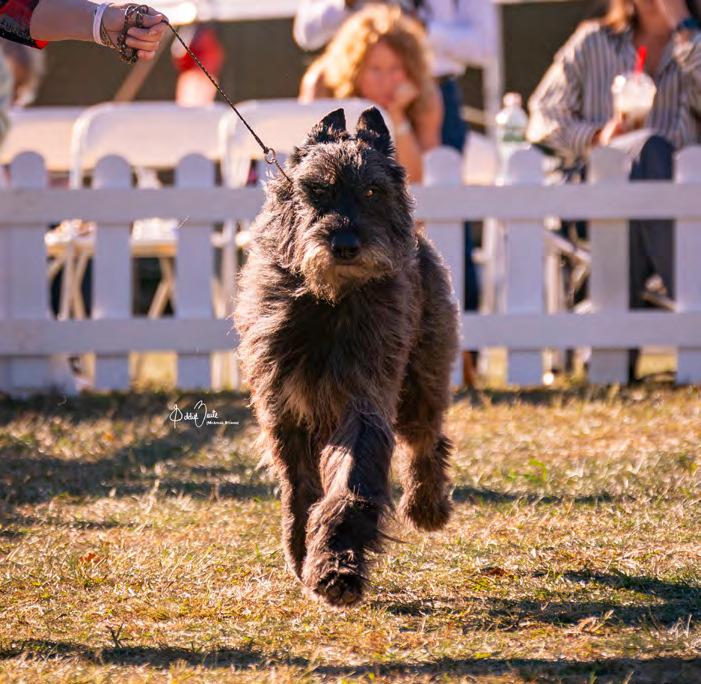






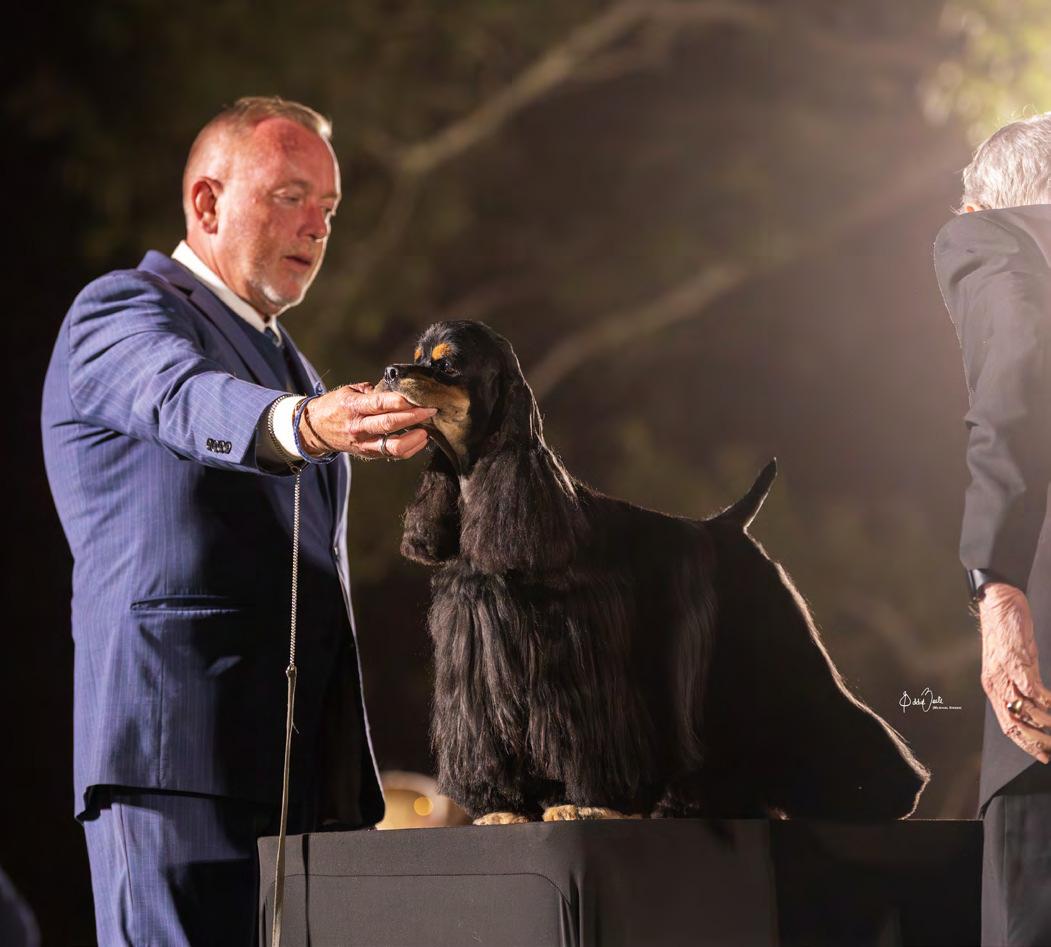















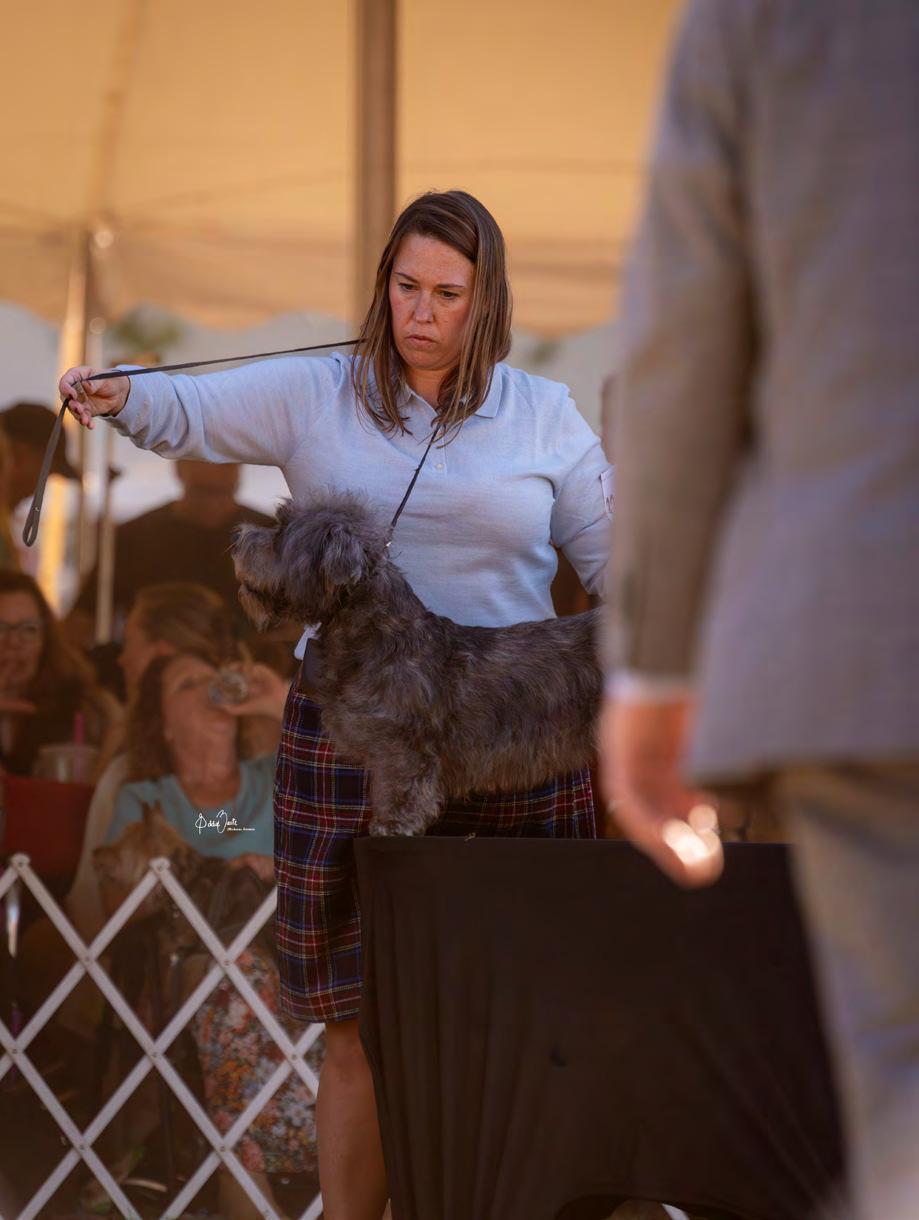

GCHS SPINDLETOP’S COURTESY OF THE RED, WHITE AND BLUE
Owner: Anne Barlow. Breeder: Anne Barlow.
GCHB CAS’ SMOOTH CRIMINAL
Owner: Susan Swords & Christin Cease. Breeder: Susan Swords & Christin Cease.
GCHG ABSOLUTE DE PACO XZ DICKIES THAT’S ANYBODY BUT YOU
Owner: Robert Whitlow & Alaina Moulton & Blair Aguillard Commisso & Giuseppe Commisso. Breeder: Blair Aguillard Commisso & Giuseppe Commisso & Michelle Aguillard & P Z
GCHS FIRST CLASS DELTA OF THE RAPTOR SQUAD
Owner: Jacquelyn Fogel & Andrea Rich. Breeder: Jacquelyn Fogel.
CH ALARIC STAR SPANGLED SISTER
Owner: Gregory Armstrong & Victoria M Sottile. Breeder: Victoria M Sottile & Andrea Coppiano.

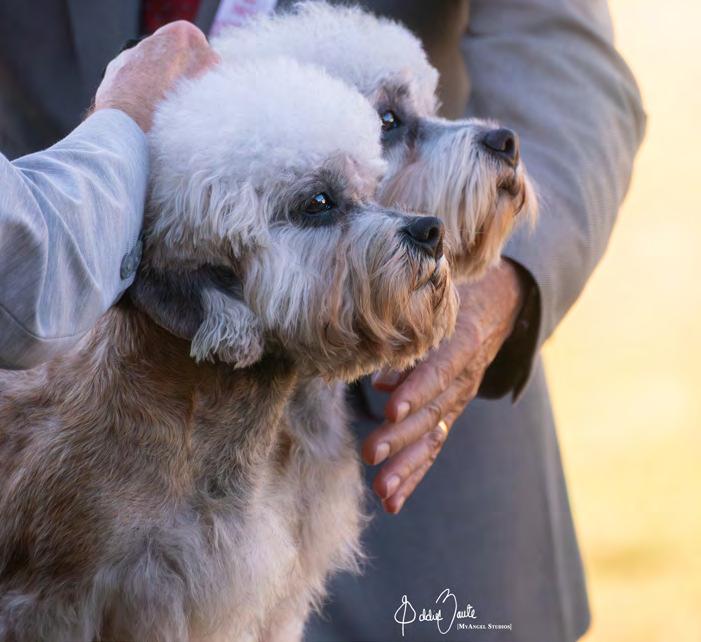



CH HJOHOO’S I’M ADDICTED TO HJO
Owner: Elisabeth Teodorsson. Breeder: Elisabeth Teodorsson.
CH TOP SHELF S.E JULERR IN THE MILE HIGH CLUB SBN RATN CGC
GCHB EVERLAND CASTLE
Owner: Michael Radzinski. Breeder: Jennifer Hecker & Megan Vandenberg.
GCH RANDOM RIDERS UP
Owner: Hisae Dickey & Edward Boyes & Bill McFadden. Breeder: Bill McFadden
GCH CHERON’S LOCKED AND LOADED
Owner: Ronald Purcell & Krystal Sullivan & Cheryl Purcell. Breeder: Cheryl Purcell & Ronald Purcell.


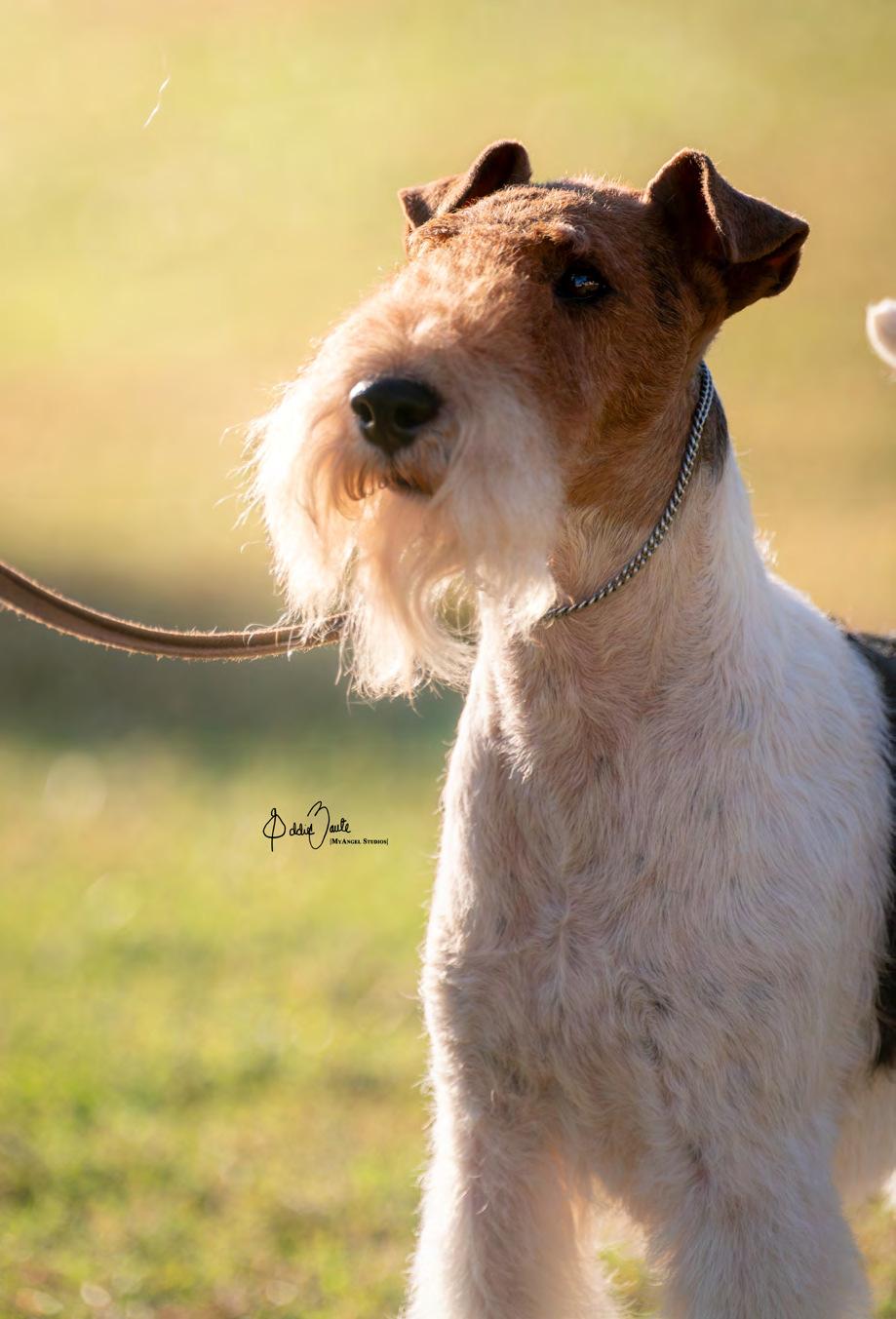
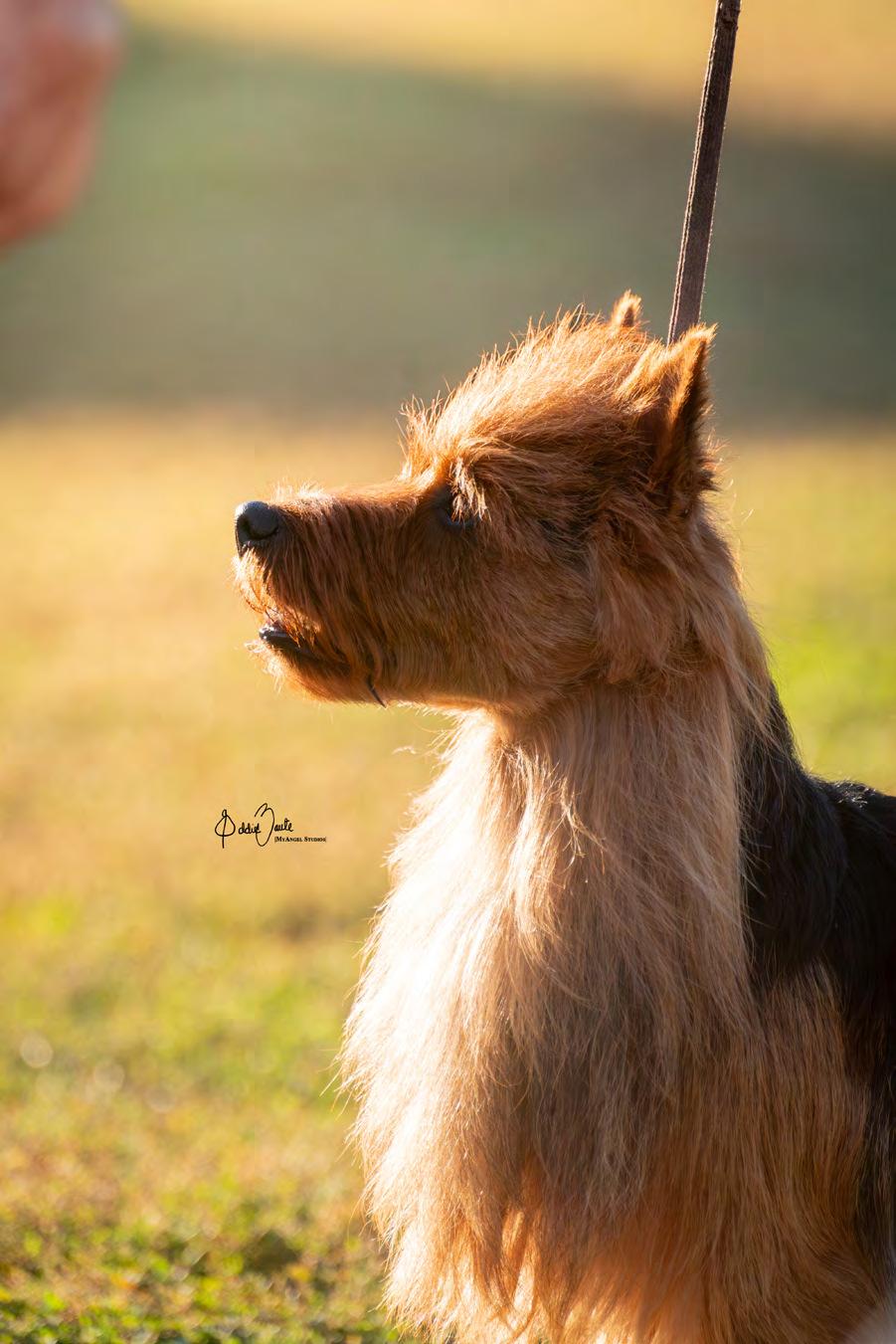


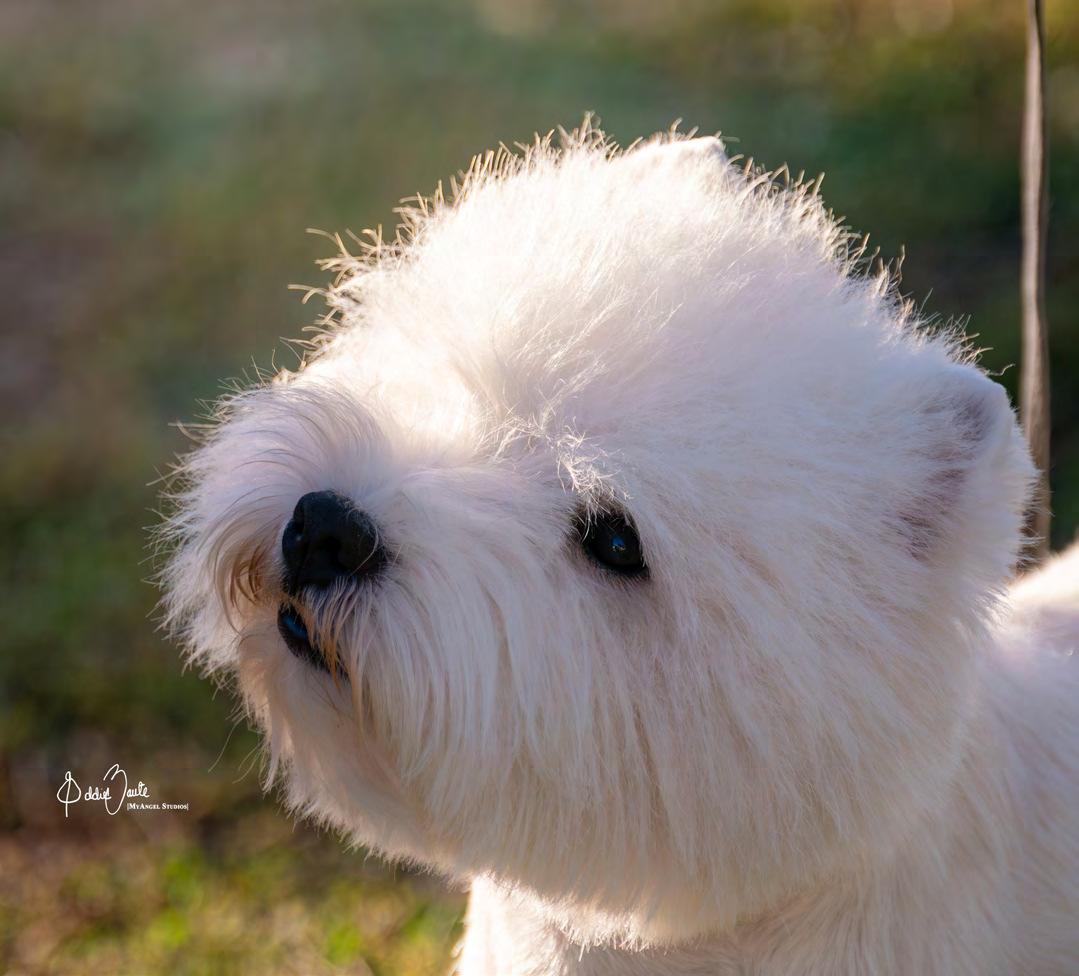




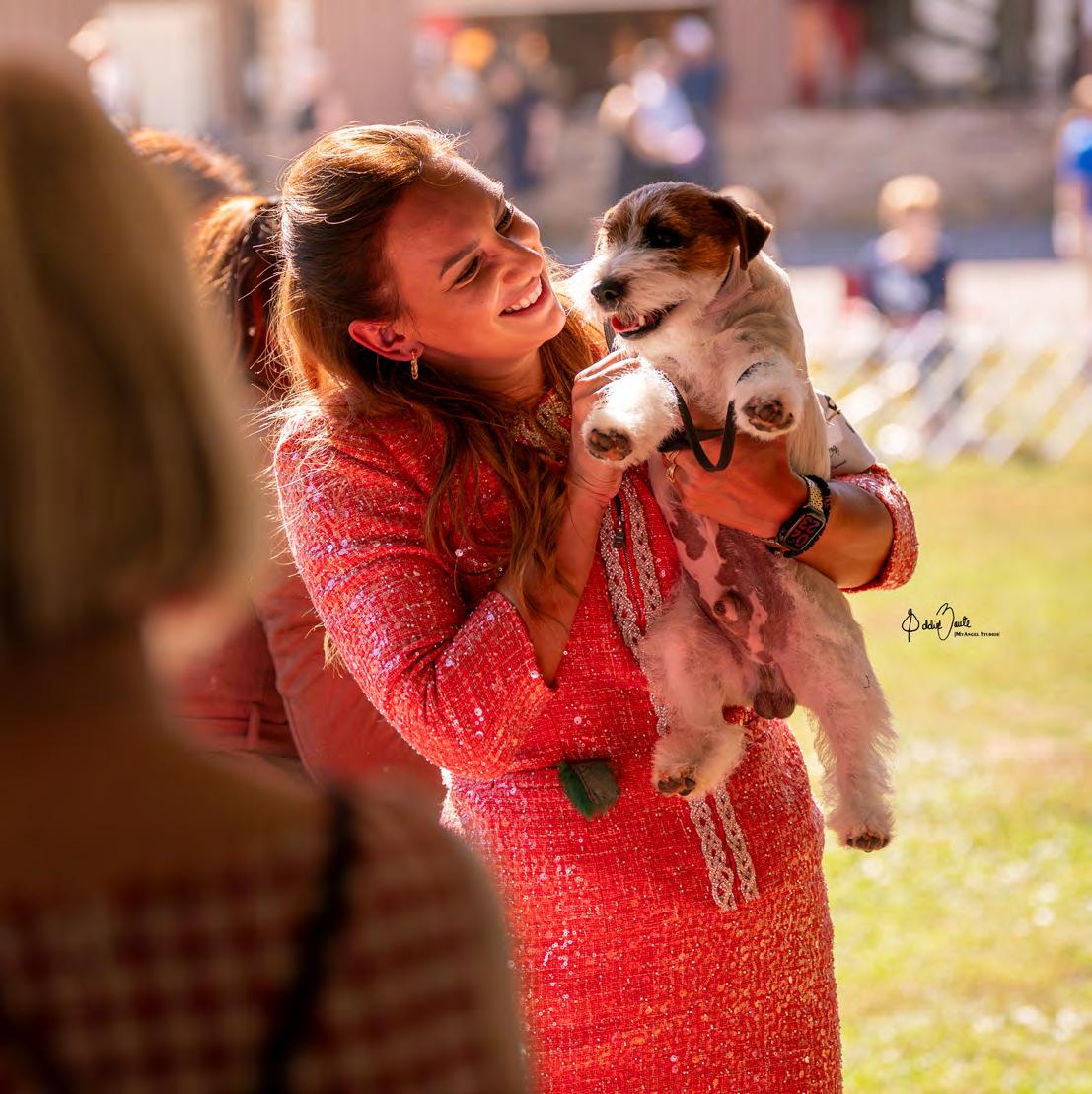
CH NORDLICHT VON DEN SCHOENEN BERGEN
Owner: Friedrich Wilhelm Schoeneberg. Breeder: Friedrich Wilhelm Schoeneberg.
GCHS EVEREST N MOSAIC’S MR. PERFECTLY FINE
Owner: Olivia Uyeno & Breanna Uyeno & Ava Hata. Breeder: Rachel Jonas & Breanna Uyeno & Olivia Uyeno & Teena Uyeno & David Jonas & Gabriel Jonas.
MINIATURE BULL TERRIER
HAVANTA BULL SABOTAGE
Owner: Teri Rumer & Cathy Sodomsky. Breeder: N V Martynova.
GCHS CARMEL MR. JOE ADAMIS
Owner: M Lande & M Jacobs & J Constantine Amodei & L Constantine Amodei. Breeder: C Ewer & M Lande & M Jacobs & S G Soos Kazel & S Coulter.
NORFOLK TERRIER
GCHB AVALON’S GRAND VOYAGE BN RI JE TKN CGC
Owner: Lori Pelletier & Susan Newell DVM. Breeder: Lori Pelletier.
NORWICH TERRIER
CH PARADYM DOUBLE DARE YA
Owner: Joanne Roga & Kelly Wood & Bruce Borden. Breeder: Kelly Wood.
PARSON RUSSELL TERRIER
GCH CLASSIC’S HIGH VOLTAGE ZAP!
Owner: Russ & Tricia Stanczyk & Jennifer Johnston & Joe Pavlic & Debbie Rathgeber. Breeder: Russ & Tricia Stanczyk & Jennifer Johnston & Joe Pavlic & Debbie Rathgeber.
RAT TERRIER
GCHP MERAKI INTRIGUED BY THE BEES
Owner: Stacy Zimmerman & River Ridge KNL & Jennifer Chappell & Lenore Hedemark. Breeder: Jennifer Chappell & Stacy Zimmerman & Stacy McWilliams.


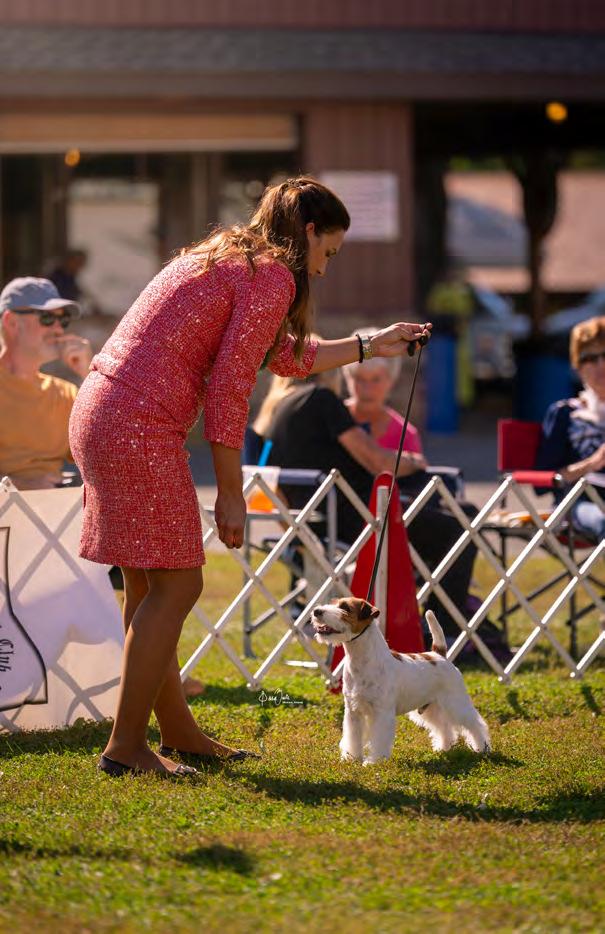

MONTGOMERY KENNEL CLUB DOG SHOW
CH BROTHERHOOD OF JACK’S YANKO A NE STANKO
Owner: Rasko Katic. Breeder: Rasko Katic.
GCHG INVERCREST DARK INTRIGUE VIA MACBLAIN
Owner: Daphne Eggert. Breeder: Dr Carol Blain & Lori Tuttle.
GCHG PEGFIELD TINTERN TICKLED PINK
Owner: G Franckowiak & P Browne & H Sutliff III & P Harbison & C Jennings. Breeder: S W Sweatt & C V Secher & C L Jennings & H Sutliff III & P Browne.
GCH CRAGSMOOR SKYE BOY IS THAT GOOD
Owner: Eugene Z Zaphiris. Breeder: Cragsmoor Knl & Terry Miller & Dominque Dube.
GCH STAR RAG DOLL
Owner: Diane M Kortgeode & Denise Daniel. Breeder: Diane M Kortgeode & Denise Daniel.
CH BLACK COUNTRY’S THE NATURE BOY
Owner: John Diaz & Darren Waheed. Breeder: John Diaz.
MONALINE UNSTOPPABLE WITH SNOWARD
Owner: Vladimir Pijunovic. Breeder: Ann Bark & Vladimir Pijunovic.
CARAT OF ICE DE LA POMME
Owner: Phavida Jaruthavee & Justyna Skrobiszewska. Breeder: Phavida Jaruthavee.


GCHG INVERCREST DARK INTRIGUE VIA MACBLAIN
Owner: Daphne Eggert
Breeder: Dr Carol Blain & Lori Tuttle.









What brings you to the United States this show season, and which shows are you most excited to participate in?
I’m coming to the United States because of my love for cynology and to compete in the shows here with Argentine dogs. The shows I’d most like to take part in are the Royal Canin Cup in Orlando, the Florida Circuit, and Westminster.
How does the dog show scene in the United States differ from the shows in your home country?
It differs in the number and quality of the dogs, as well as the level of professionalism in the competition. In my country, shows only take place on weekends, and sometimes there are just one or two shows a month.
Which breed(s) are you presenting here, and what makes them special to you?
Here I’m presenting several breeds such as Doberman, Boxer, Giant Schnauzer, Curzar, and from time to time I help colleagues when their dogs overlap in different rings.
What makes showing these dogs special is the passion and the pleasure of being in the ring—competing in this sport is very beautiful, and competing at shows here in the United States is especially meaningful.
What is the most challenging part of competing abroad, especially in the United States?
Competing abroad is a challenge—knowing that the profession of dog handler is valued and respected, and competing alongside many highly accomplished professional handlers. I also try to contribute my own knowledge and professionalism gained during 35 years of experience helping many world-renowned handlers.

Do you have a favorite venue or city for dog shows in the United States? What makes it memorable?
My favorite city is New York, where the most important show for me—Westminster Kennel—is held at Madison Square Garden. Being at that show is something incredible.
How do U.S. judges’ styles or expectations compare with those in your country?
In general, U.S. judges and Argentine judges are not very comparable, but all of them are excellent—not only those from the U.S. and Argentina, but from all over the world.
What preparations do you make before traveling internationally with show dogs?
For every trip I take with the dogs to compete anywhere in the world, I try to ensure the dogs are at 100% for competition. Each trip is a new experience, and usually the nerves of flying with dogs cause a lot of stress—but things always turn out well.
What has been your favorite moment or achievement during your time competing in the United States?
My favorite achievement was at the Royal Canin Cup, where I competed with a Giant Schnauzer named Gran Houdini de Barba Negra. I won Best of Breed on one of the days, competing against many entered dogs. Another great moment was winning the Bearded Collie National, and more recently winning a Curzar specialty. But truly, every moment I’m competing in the United States is very memorable for me.
How do you stay connected with your clients and dogs back home while you’re traveling?
When I travel to compete in other countries, I’m always in communication with my clients, whether by phone calls or video calls. I always keep them informed about how their dogs are doing and the results we achieve.
What advice would you give to other international handlers who are considering competing in the United States?
I humbly believe that the U.S. has magnificent professional handlers, and you can learn something every day by observing how they prepare and present their dogs.


In the world of dog shows, we celebrate connection, excellence, and community. But when abuse or misconduct occurs, that same community can suddenly feel isolating—especially if you’re not sure who to turn to. That’s why SHOW-SAFE’s Victim Services exist: to offer confidential, compassionate support to anyone in the dog show world impacted by abuse or misconduct.
Whether you’re facing an unsafe situation right now or carrying the weight of something that happened long ago, we’re here—without judgment, without pressure, and without delay.
Immediate Response Helpline (24/7) A real-time, confidential helpline for when you’re in an unsafe or uncomfortable situation and need to explore your options for safety.
Aftercare Services Personalized, longer-term survivor supportfocusedonhealing,stability,andempowerment— available when you’re ready, at your own pace.
By Brody Cavanaugh, SHOW-SAFE Aftercare Director, & Erin Crowley, SHOW-SAFE Immediate Response Director.
Both services are built on trust, privacy, and the understanding that no two journeys are the same.
Anyone in the dog show community—regardless of age, gender, income, role, or club affiliation. We respond to all forms of abuse and misconduct, including:
Elder abuse
Physical or sexual abuse
Emotional abuse or harassment
Domestic violence
Grooming or bullying
Stalking or exploitation
Human trafficking
Neglect of basic needs
If it makes you feel unsafe, it matters. If you’re unsure, call anyway—we’ll help you sort it out.
SHOW-SAFE is a victim-centered organization. While we take a zero-tolerance stance against all forms of abuse and misconduct, our role does not include identifying, investigating, or restricting individual offenders—that responsibility belongs to law enforcement, the courts, clubs, and the AKC.
What we do is Recognize. Respond. Restore. We work
withourcommunitytorecognizerisksandwarningsigns to help prevent harm; we respond with resources and compassionate, victim-centered support; and we work to restore safety, healing, and trust—both for individuals and for the sport as a whole.
Through advocacy, education, and community collaboration, we champion policies and practices that make it clear: offenders are not welcome here, and victims are never alone.

You’ll speak with a trained member of our small, dedicated team—currently just three people—who follow strict processes to protect your confidentiality. Others affiliated with SHOW-SAFE do not have access to caller information.
We’ll listen and never push as we provide options to help you figure out what you need to feel safer and begin healing. We mobilize information and resources to meet your current need, whether that means arranging a safe placeforthenight,helpingfileapolicereport,connecting you to mental health services, or simply being there so you’re not alone.
We cannot provide 911-level emergency response, and we are not mental health professionals. If you are in immediate danger, call 911. If you are experiencing suicidal thoughts, call 988. Once the crisis has stabilized, we are here to help you navigate what comes next.
Your experience, your timeline, your choice.
Here’swhatotherswhohaveaccessedourvictimservices have had to say:
“I felt so alone until I called SHOW-SAFE. All of a sudden, I had the support I needed, and the trajectory of my life changed.”
“SHOW-SAFE is proof that things really can get better. They gave me the foundation to make the first steps possible—because those are usually the hardest.”
At its best, the dog show world is built on respect, sportsmanship, and a shared love of dogs. When abuse or misconducthappens,itharmsnotonlytheindividualbut the integrity of our entire community.
The reality is that these problems are not unique to our sport; they exist anywhere people gather.
By offering direct victim services, we provide immediate protection and support for those who have experienced harm. And as healing begins, we walk alongside them on thejourneyfromvictimtosurvivor—fosteringresilience, restoring trust, and ensuring that every person in our community has the opportunity not just to survive, but to truly thrive.
The most important thing you can do—for yourself or someone else—is to reach out.
Immediate Response Helpline (Available 24/7): 1-859203-8683
Aftercare Services: Submit an application for support or email aftercare@show-safe.org for more information.
Learn More
www.show-safe.org

